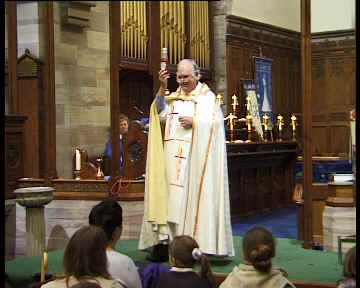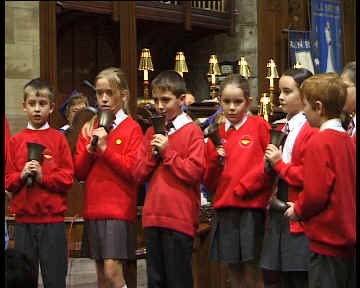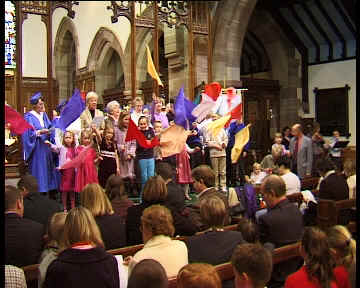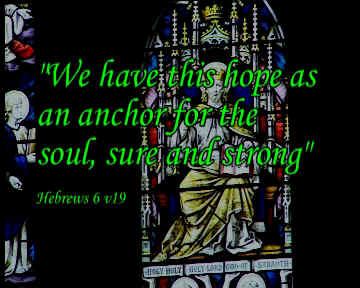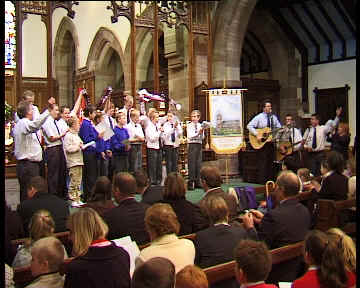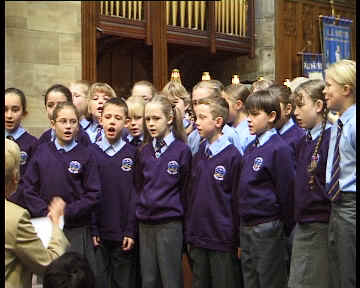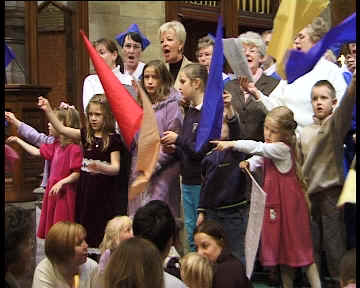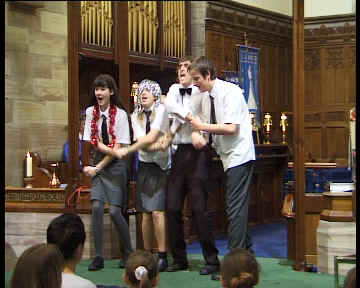
THE OLD CHAPEL
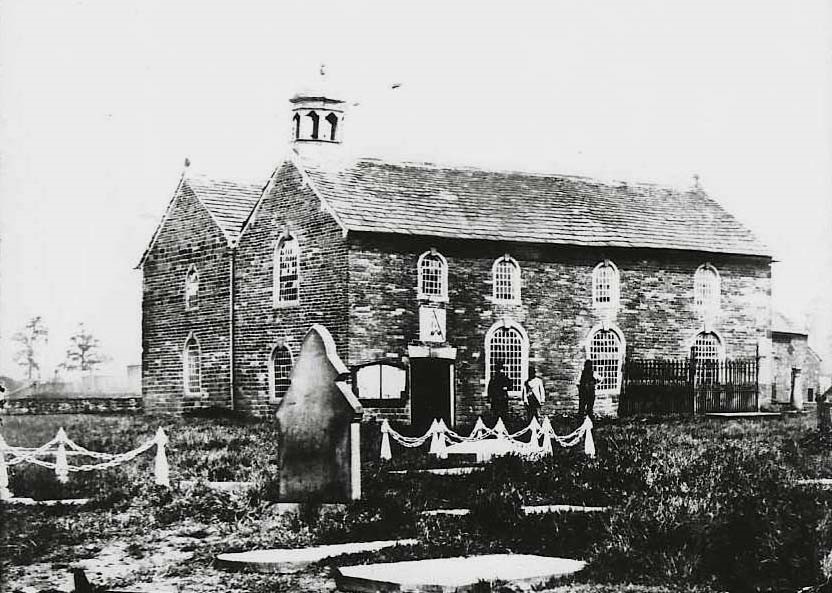
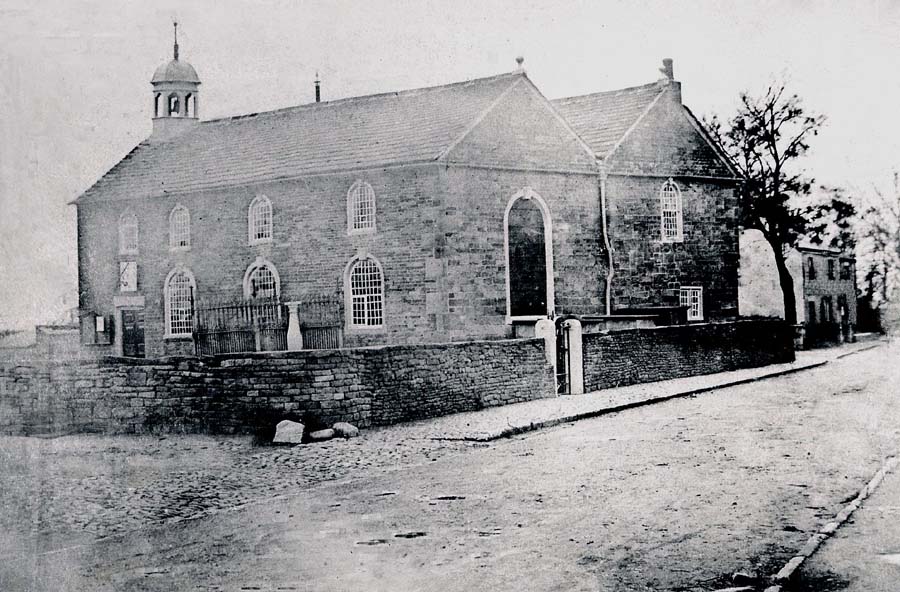
THE OLD CHAPEL
A chapel existed here at the time of the Reformation. Built as a chapel-of-ease due to its distance from the mother church at Prescot it was under the control of the vicar there and was served by curates appointed by him. The inhabitants of Rainford had to pay dues to the parish church at Prescot. The first known curate was named as Laurence Roby in 1541, a date which coincides with the establishment of the Diocese of Chester, prior to which Prescot fell within the jurisdiction of the Diocese of Lichfield.
Despite the Reformation the chapel remained Catholic; as did much of this part of Lancashire. It was built on land owned by the Lathom family of Mossborough Hall and supported by them. Henry Lathom was persecuted for his Catholic faith and in 1583 he fled from the county but was eventually imprisoned in 1590. This persecution coincided with the appointment of Thomas Meade, “a devout Puritan Minister”, as the vicar of Prescot who gained control of the chapel. From this time on the Lathoms kept a seminary priest at Mossborough Hall.
For the first half of the seventeenth century the chapel was served by a succession of Puritan curates appointed by the vicar of Prescot. About 1650 Prescot lost some of its control through neglect and the inhabitants appointed Presbyterian ministers of their own choosing. In 1672 James Bradshaw, a staunch non-conformist, was appointed minister. With the passing of the Act of Toleration, when conventicles or meetings of non-conformists became recognised congregations, Bradshaw registered the chapel as a meeting place for Protestant Dissenters in July 1689 and within a year his congregation numbered about two hundred people.
The Dissenters foresaw the likelihood of their eviction from the chapel and in the following years they registered Bradshaw’s own house and three others as meeting places. When James Bradshaw died in 1702 the chapel was recovered by the established Church of England authorities at Prescot and Ralph Sherdly. “a good Establishment man” was appointed curate.
(see Independent Chapel for the Dissenters history)
After the departure of the Lathoms the old chapel suffered from lack of endowment and the problems of a decaying building and clergy to support but throughout the eighteenth century financial matters improved. In August 1758
‘The present Warden was ordered to pull down the South side of the old end of the said Chapel and rebuild it and uncover that side of the roof and repair the same, and the whole Chapel be whitewashed & decently beautified’.
With an expanding population in the village the Vestry Meeting of May 1770
Agreed that the chapel warden should –
Enlarge the said Chapel with a new bay of building and to erect a Gallery over such enlargement as also along the North side of the Chapel, with pews or seats therein and a Staircase to lead thereto and afterwards dispose of the Seats or pews on the Ground below as well as in the Gallery above to such of the inhabitants as would purchase them at the best prices that will be given, for the use of themselves and their families.
In 1787 the vestry was rebuilt and enlarged thus establishing the truly rectangular shaped Chapel of about 48 feet square which survived until its demolition some 90 years later.
It was not until 1869 that Rainford became a Parish in its own right, served by a Vicar instead of a Curate. Samuel Cavan became the first Vicar and on his retirement in 1873 he was succeeded by Gilbert Coventry Master who soon recognised the need for a new church building to accommodate a rapidly increasing population. With the support of his congregation, great efforts of fund raising, a generous donation of £2000 by Lord Derby and numerous public subscriptions, work commenced in April 1877 on the building of a new church a few yards south of the Old Chapel.

The work was soon completed at a total cost of £7027 (but without the tower which was added in 1903), and a Service of Consecration was held on All Saints Day 1878. With a fine new building and free seating for 550 persons the old chapel which had stood for over 300 years was finally demolished.
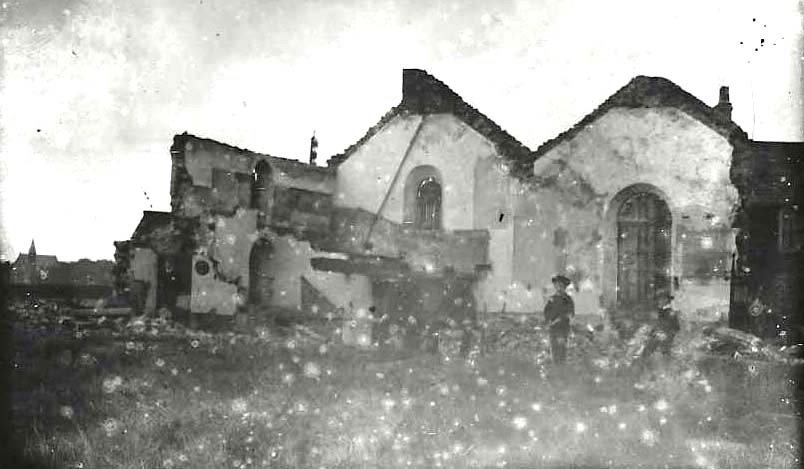
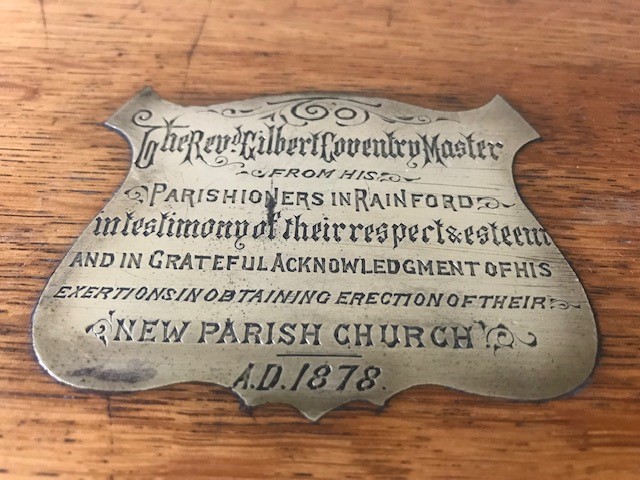
To
The Revd. Gilbert Coventry Master
from his
Parishioners in Rainford
in testimony of their respect & esteem
and in Grateful Acknowledgment of his
exertions in obtaining erection of their
NEW PARISH CHURCH
A.D.1878
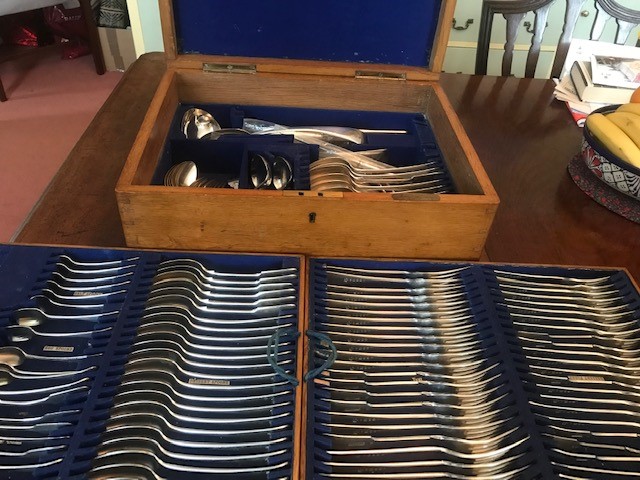
RAINFORD METHODIST CHAPEL
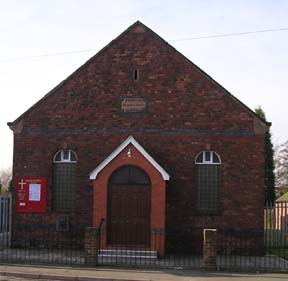
Before 1883 the Primitive Methodists of Rainford had no place in which to worship except two small cottages situated at the opposite ends of the village, one known as Rookery and the other as Rainford Junction. One of the cottages was reputed to have been loaned to them by the Rainford Coal Company.
Two societies had formed, consisting mainly of working men and their wives, but each working long and hard with the same will and determination to find better accommodation of their own. On Good Friday 1883 the two societies amalgamated when the Memorial Stone of the New Primitive Methodist Church was laid by Mr. Richard Pennington, jun, of Muncaster Hall, on land in Ormskirk Road that had been secured from the Earl of Derby by Rev. Mr. Wilshaw for a nominal annual ground rent. Mr Pennington gave a donation of £50 towards the cost of the building.
The weather for the occasion was very favourable and many people, including some from St.Helens and other surrounding districts, came along to join in the celebrations. These were concluded by a meeting being held in the Congregational School which had been loaned for the occasion.
After the Memorial Stone had been laid, the builder, another Mr. Pennington of Rainford, worked very quickly and soon the Chapel was completed. At a cost of £330, and the capacity to seat 200 worshipers, the opening services took place on Sunday, 15th July, 1883, with sermons by the Rev. E.A.Davies of Stalybridge, and the Rev. T. Atkinson, Rainford Congregational Church. The following Sunday, sermons were preached by the Rev. J. Sadler, of Blackburn and Mr. J. Hewitt of St.Helens. After 128 years, in 2011 the Chapel closed its doors; the last service was held on the 27th March.
FLOWERS FOR CHRISTMAS 2005
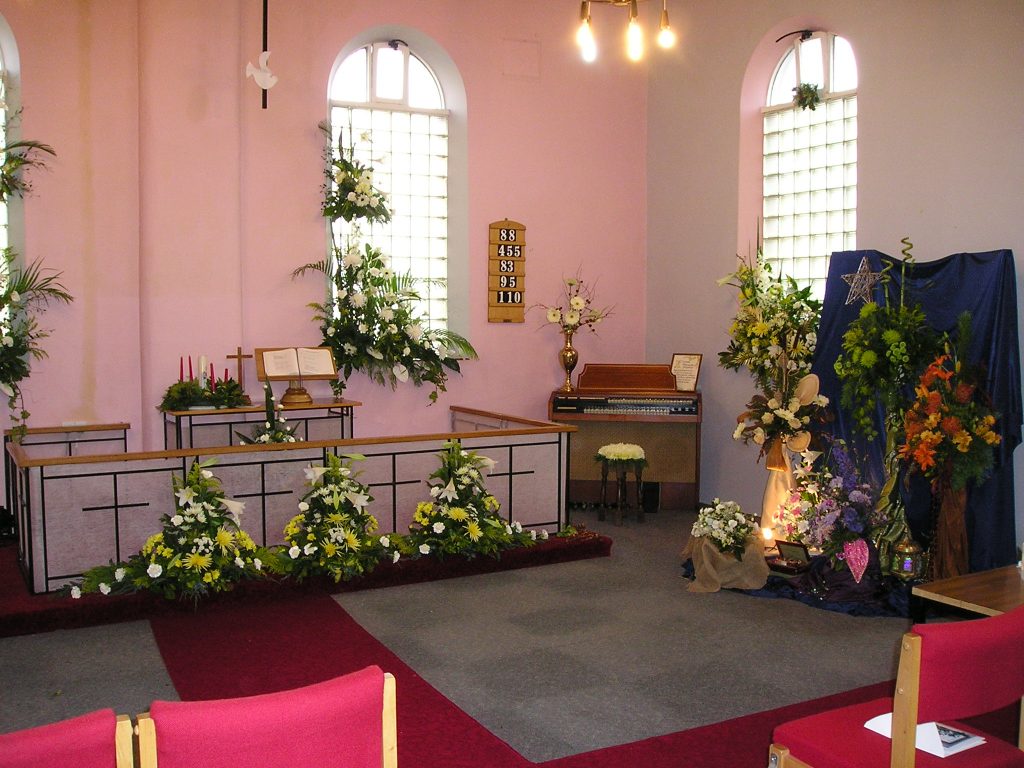
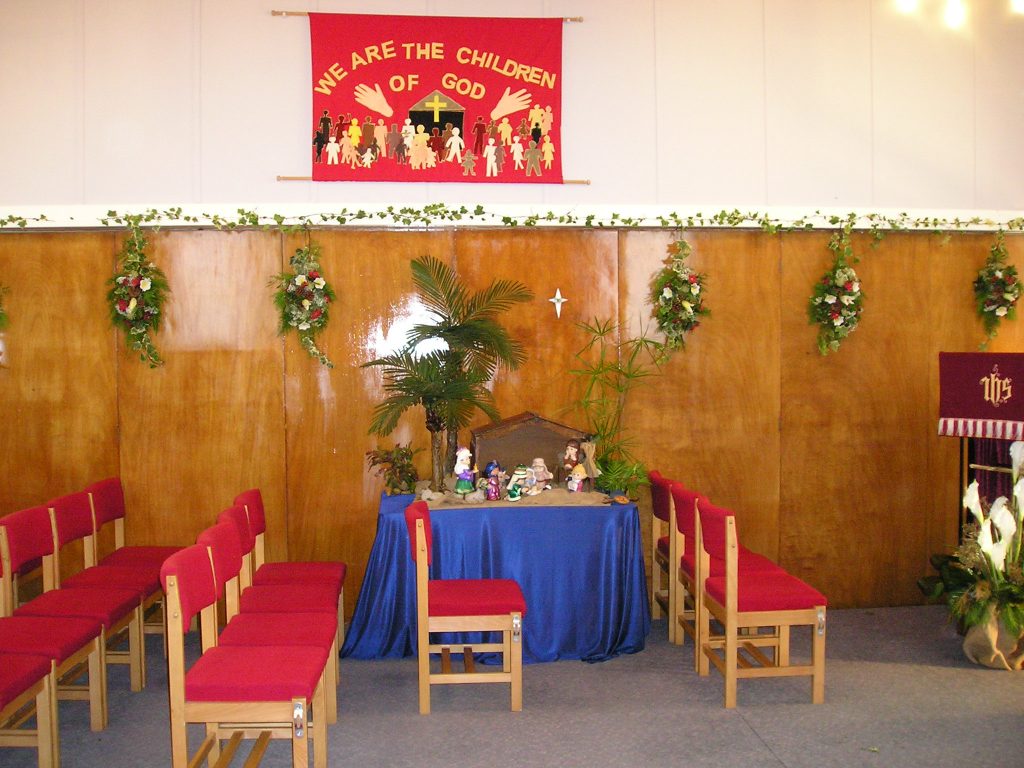
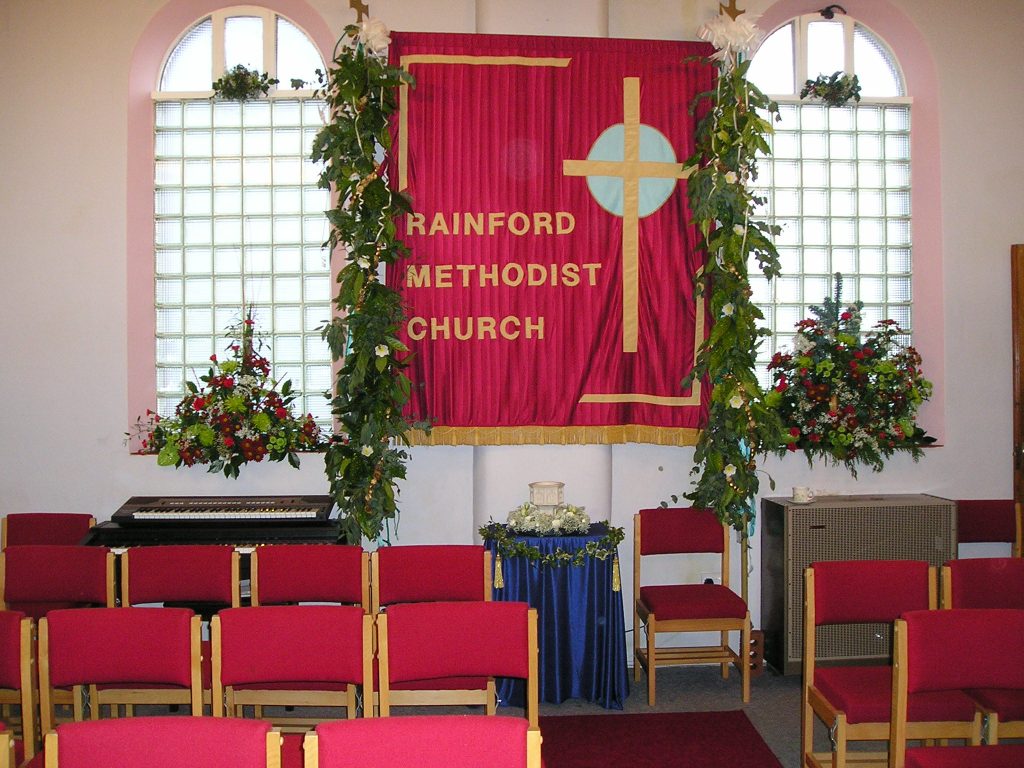
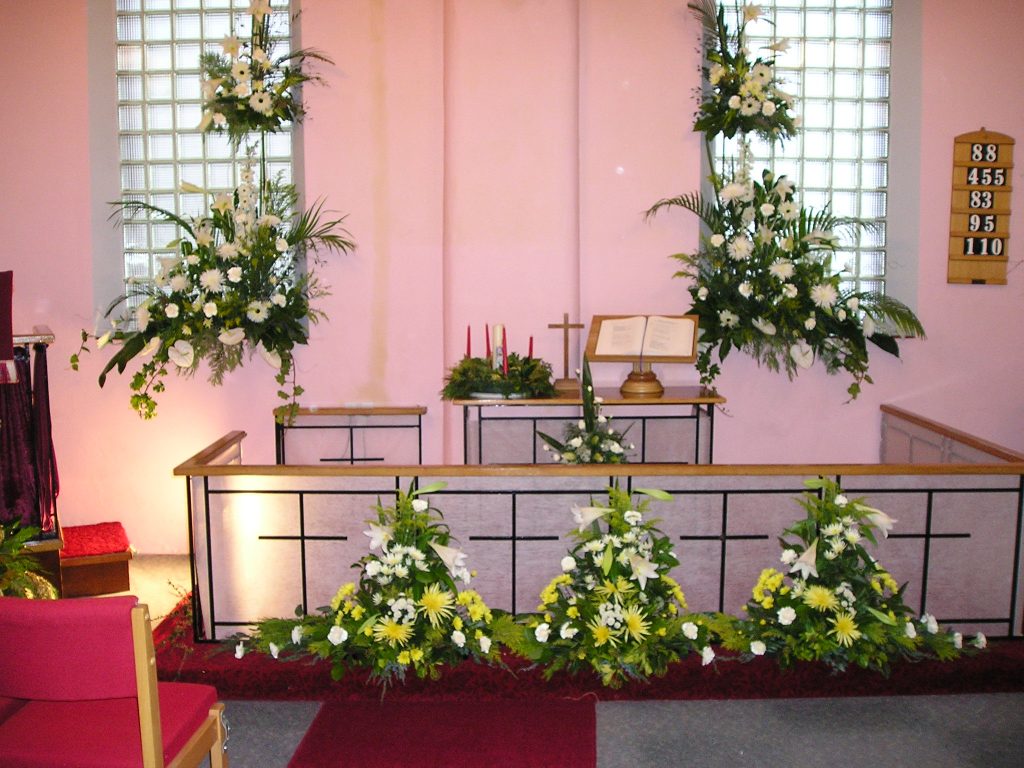
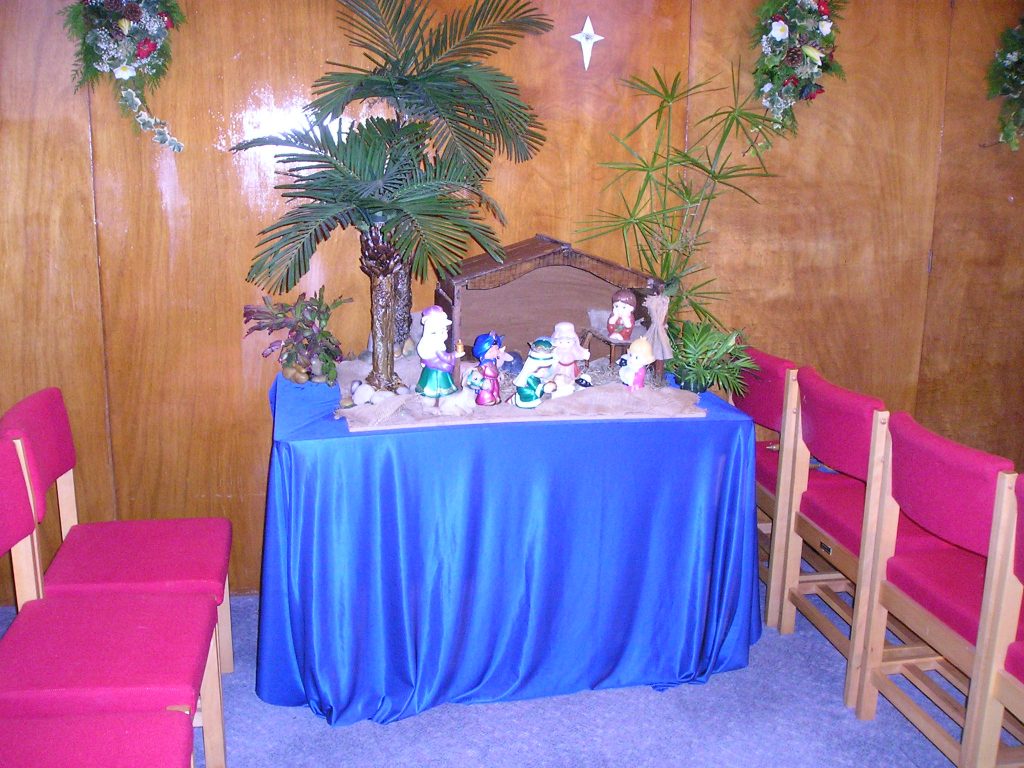
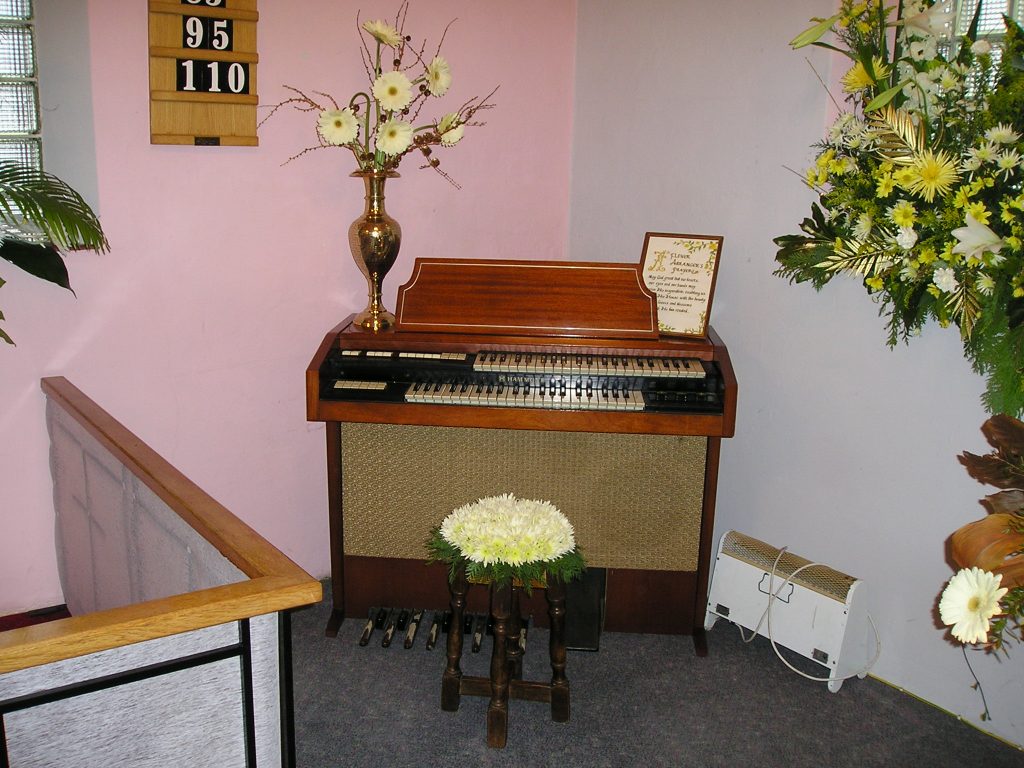
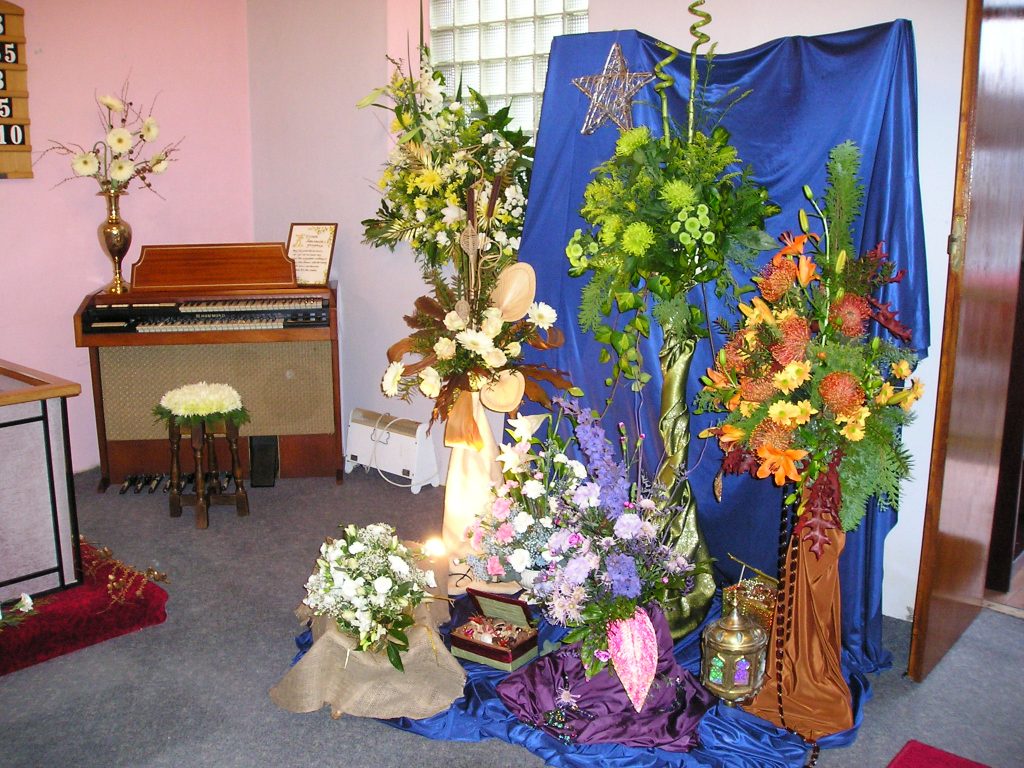

RAINFORD CORPUS CHRISTI CHURCH
Ever since the Reformation the Lathom and the Molyneux families kept a priest in their residence at Mossborough Hall but after the last priest to serve in 1744 the Roman Catholic Church had no representation in the village, its followers having to journey the four or five miles to St. Helens or Billinge in order to worship together.
This state of affairs lasted until almost the end of the 19th century when in 1869, the Rev. Joseph Wrennall began making attempts to acquire land upon which to build. However, by his death in 1872 no significant progress had been made, mainly due to the fact that the protestant landowners refused to sell to Catholics. Offered for sale at an auction held in the Eagle and Child Inn, Rainford on the 18th September, 1873, was a piece of land of seven and a half acres owned by the family of the late Mrs. Mary Richardson of Rainford House.
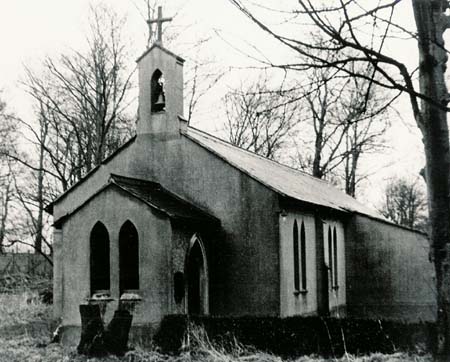
OLD CHURCH 1874
Among the potential buyers were the Rev. Father Austin Powell, Roman Catholic priest of St. Mary’s Church, Birchley, and a Thomas Mather of Billinge. Unbeknown to the others present, Father Powell had made prior arrangements with Thomas Mather to make it appear that he, Thomas Mather, was bidding against the reverend, whilst in fact bidding in conjunction with him. When the bidding reached £1,800, this being the prearranged point, the reverend indicated that he could go no further. Mr. Richard Pennington of Muncaster Hall raised the price to £2,000 which the auctioneer was poised to accept when Thomas Mather stepped forward and offered what became the final bid of £2,050. The expression of the crowd was that the priest had lost, until to their consternation Father Powell stood up and paid the money. Now the Catholic community had sufficient land to build a new church and school.
Upon acquiring the land, Father Powell’s first priority was to build a new catholic school to provide education for the children. After seeing this successfully opened on the 10th August, 1874, it was now time for him to concentrate his energies upon designing a new church which was to be built on the remainder of the land.
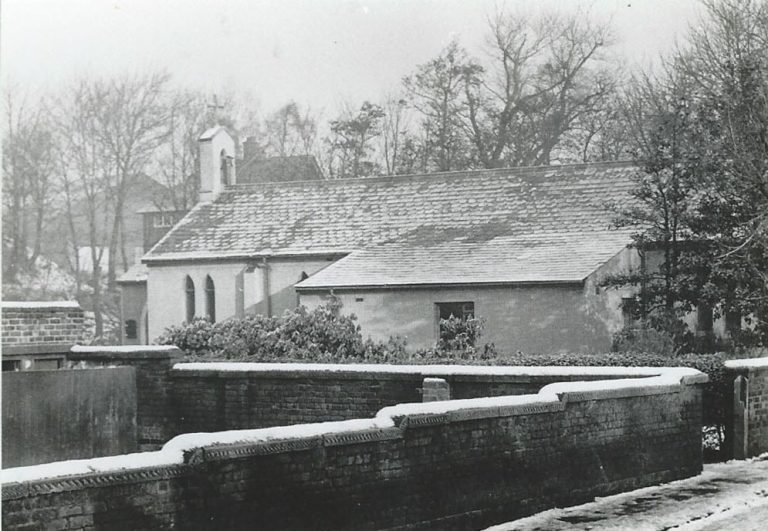
OLD CHURCH
On Sunday, 18th July, 1875, at 3 o’clock in the afternoon, the Foundation Stone of the new church was laid by the Bishop of Liverpool, the Right Rev. B. O’Reilly, D.D. A large crowd of people attended the ceremony, many of them from neighbouring areas who arrived at the nearby village station on special trains provided by the London and North Western Railway Company. The weather remained fine for the occasion and the closing collection raised £97. 2s.
Mr. J. Middlehurst, the builder, then worked untiringly to complete the building as quickly as possible. This he achieved by October enabling the opening ceremony to take place on Sunday, 17th October, 1875. Once more the service was performed by the Bishop of Liverpool, the Right Rev. B. O’Reilly, D.D. assisted by others before a congregation which far exceeded the seating capacity for approximately 200 worshippers. Now at last the Catholic community of Rainford had a place of their own in which to worship
The little church continued to serve the community for almost 105 years, the last Mass being celebrated on the 6th July, 1980, after which services continued in the newly built church across the road.
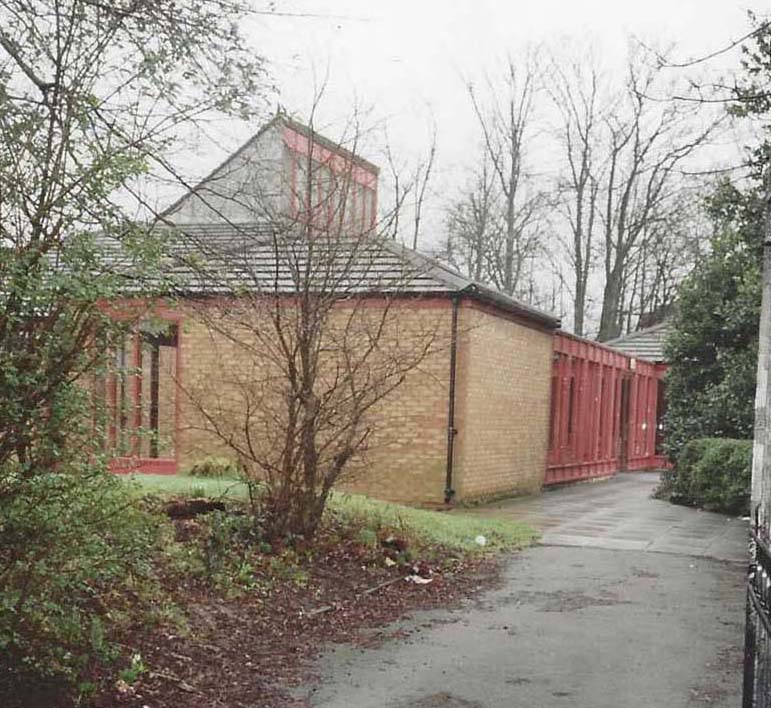
REAR VIEW OF CHURCH
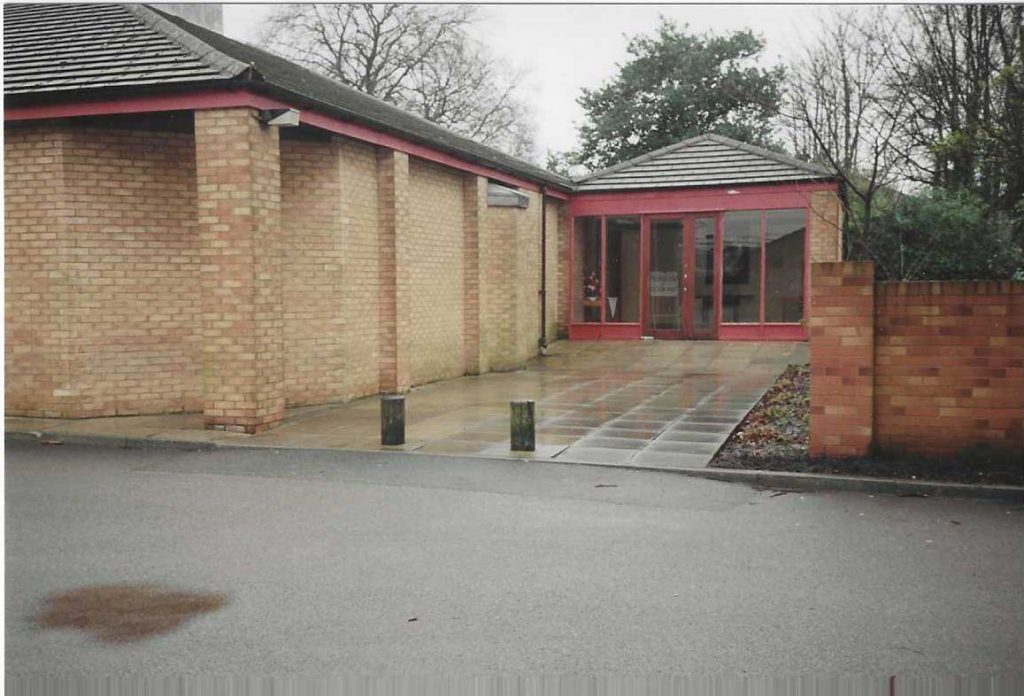
ENTRANCE TO CORPUS CHRISTI CHURCH
This was opened and blessed by The Most Rev. Derek Worlock , Archbishop of Liverpool, on July 27th, 1980.
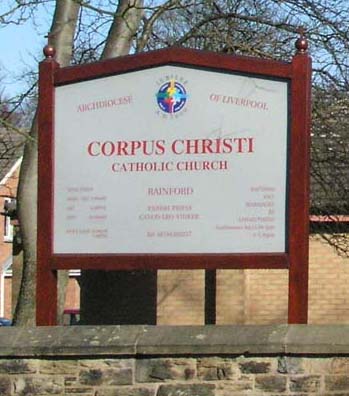
Silver Jubilee Celebrations,
23rd – 27th July, 2005
A Festival of Flowers
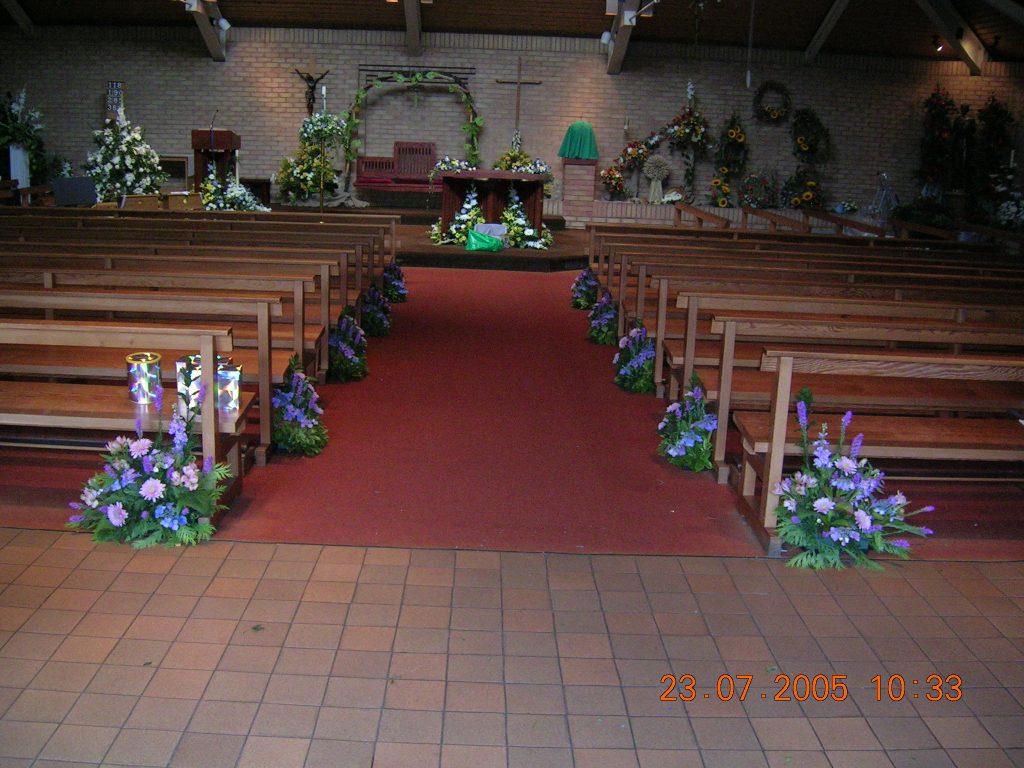
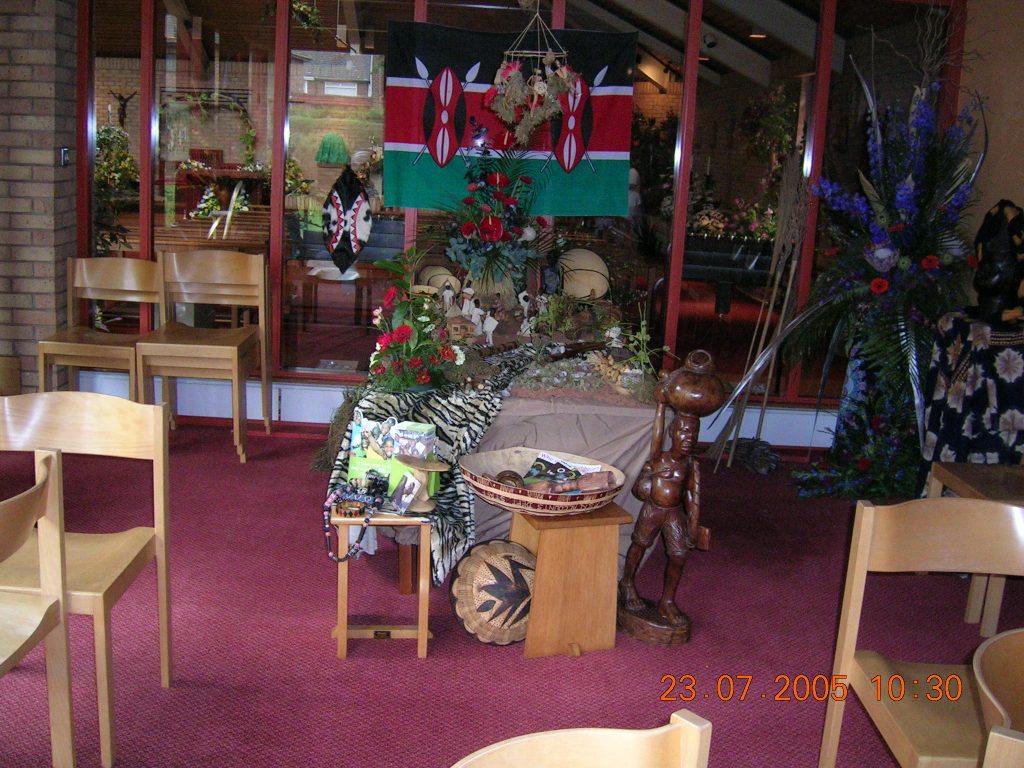
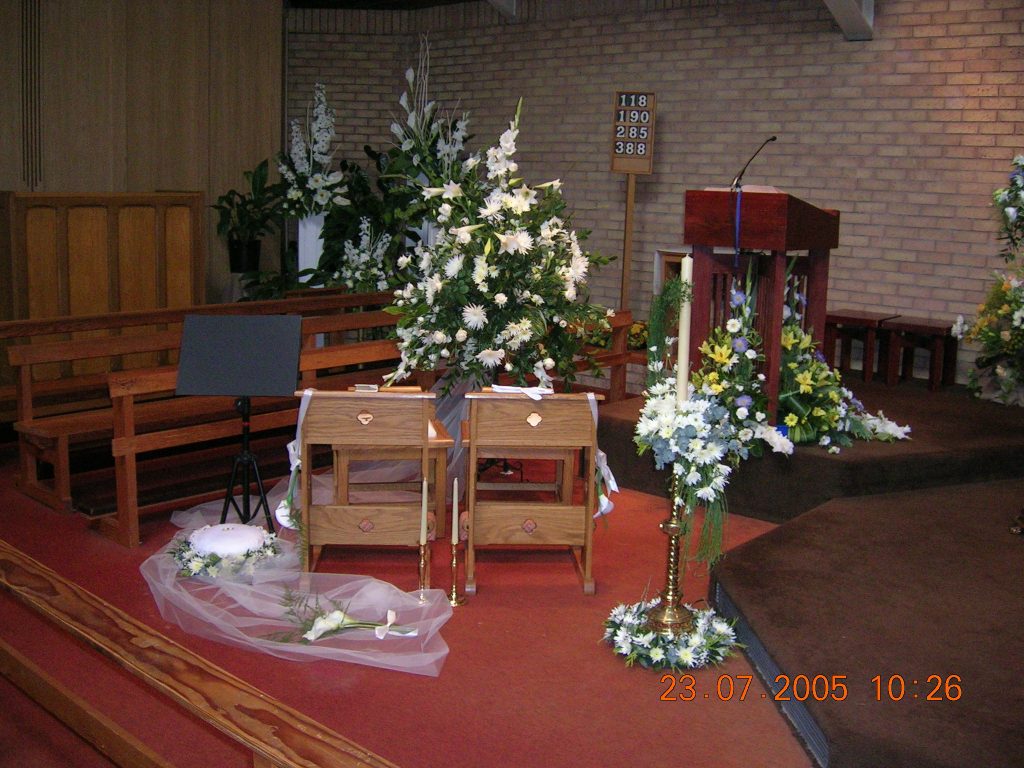
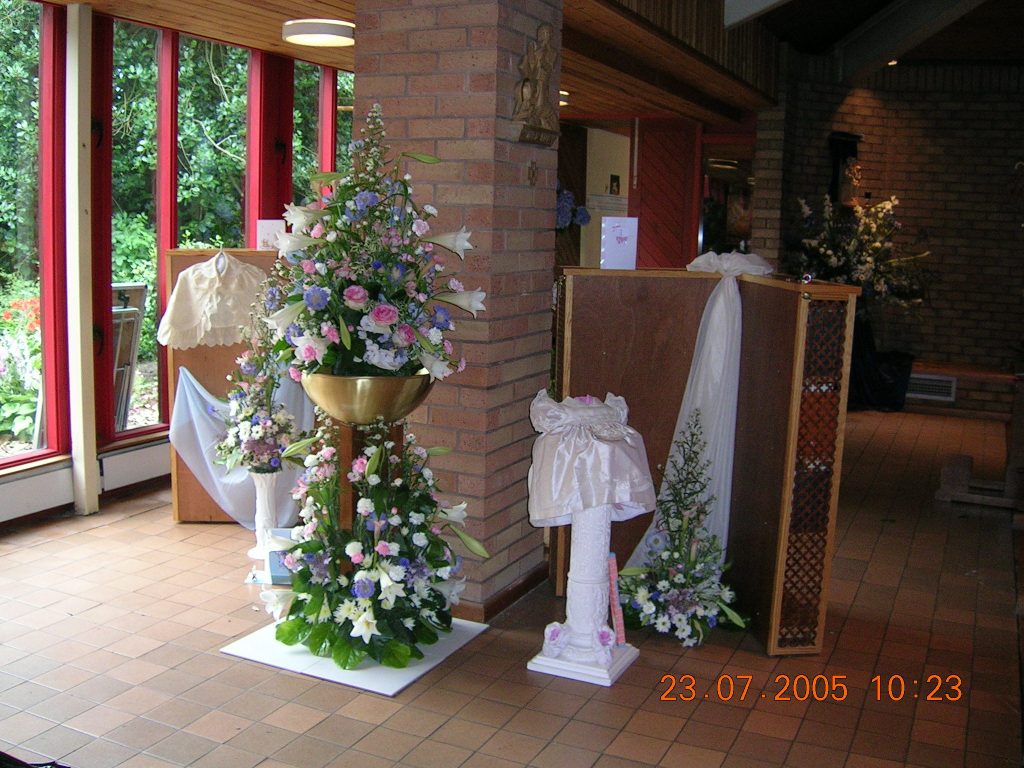
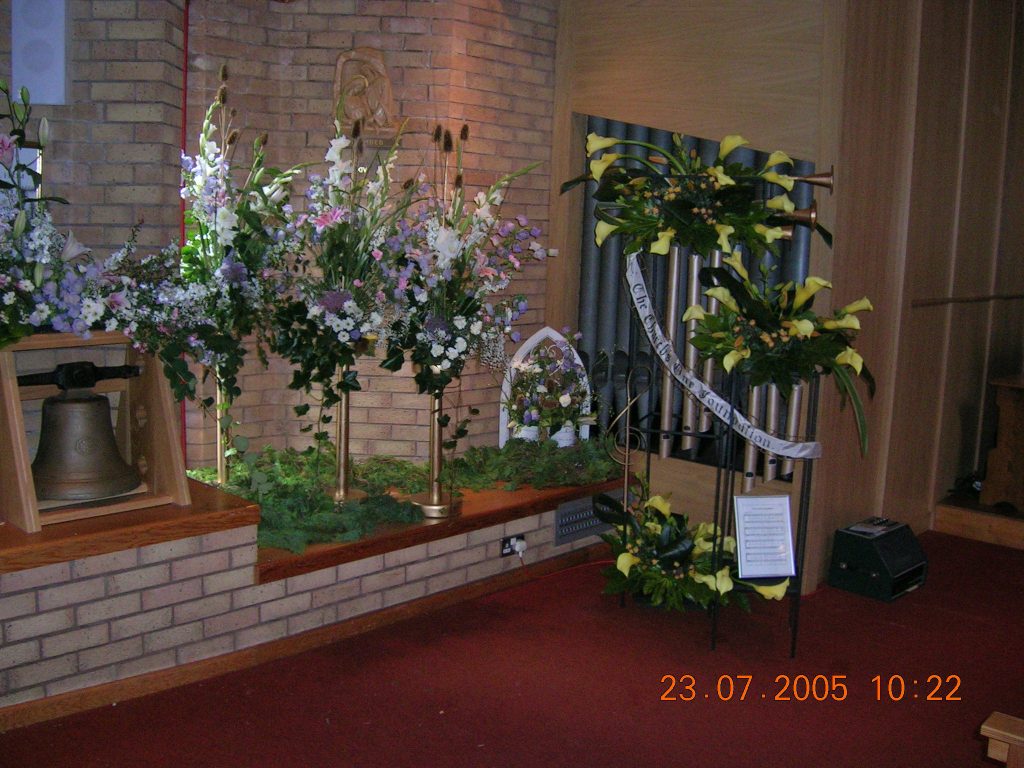
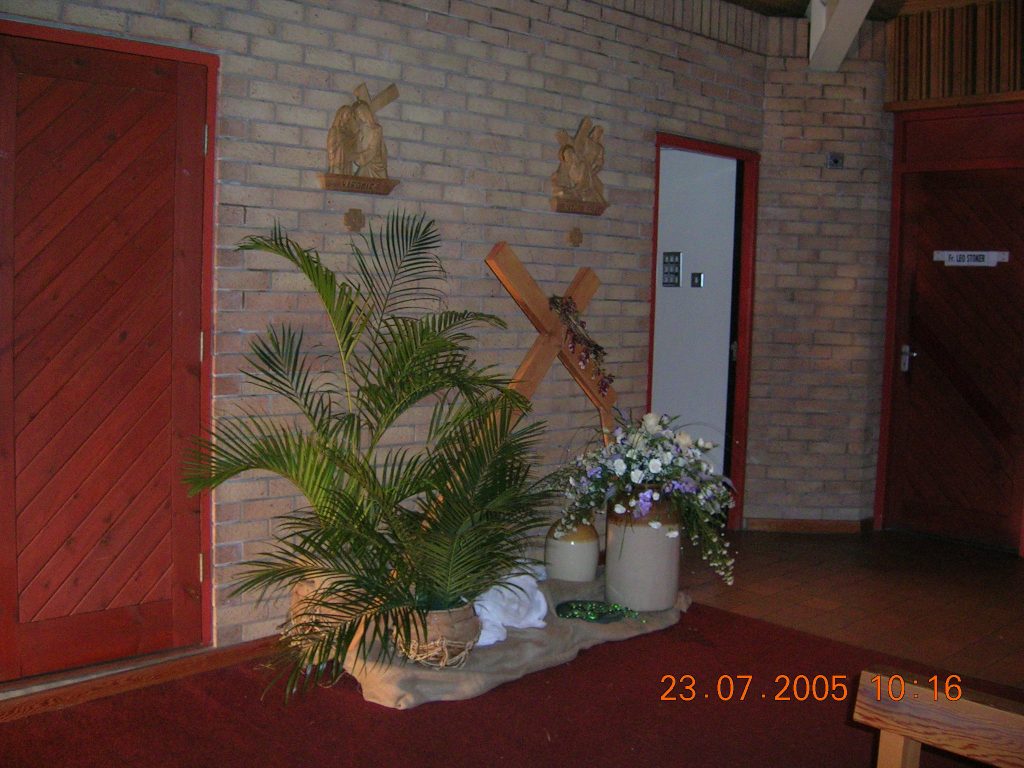
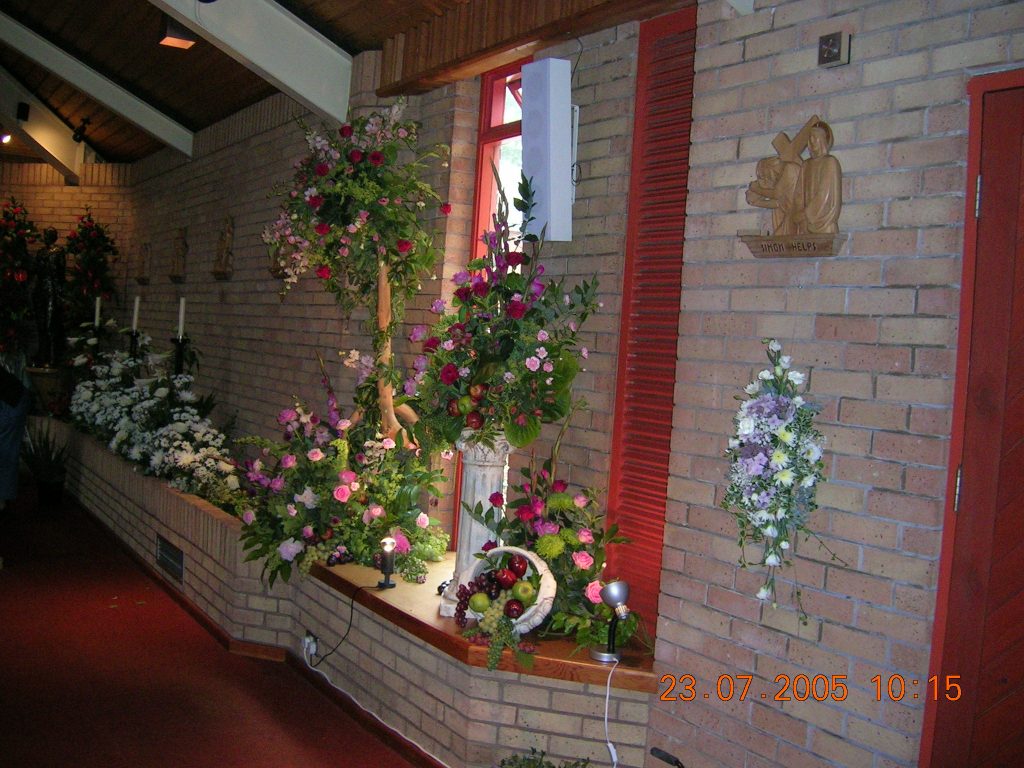
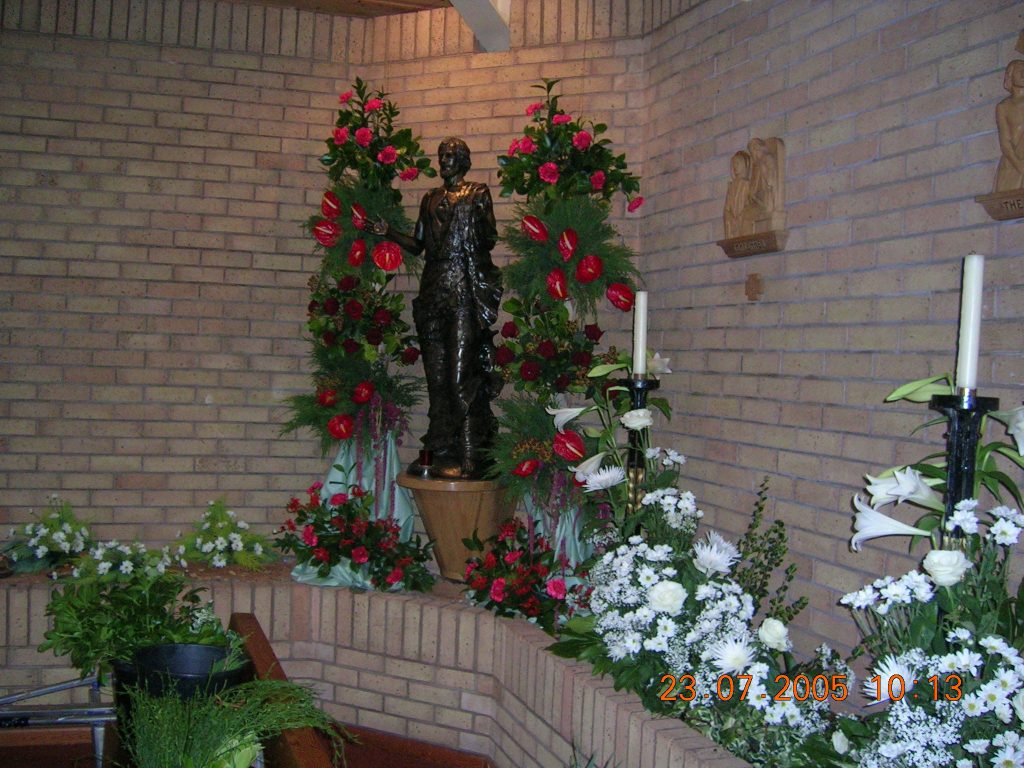
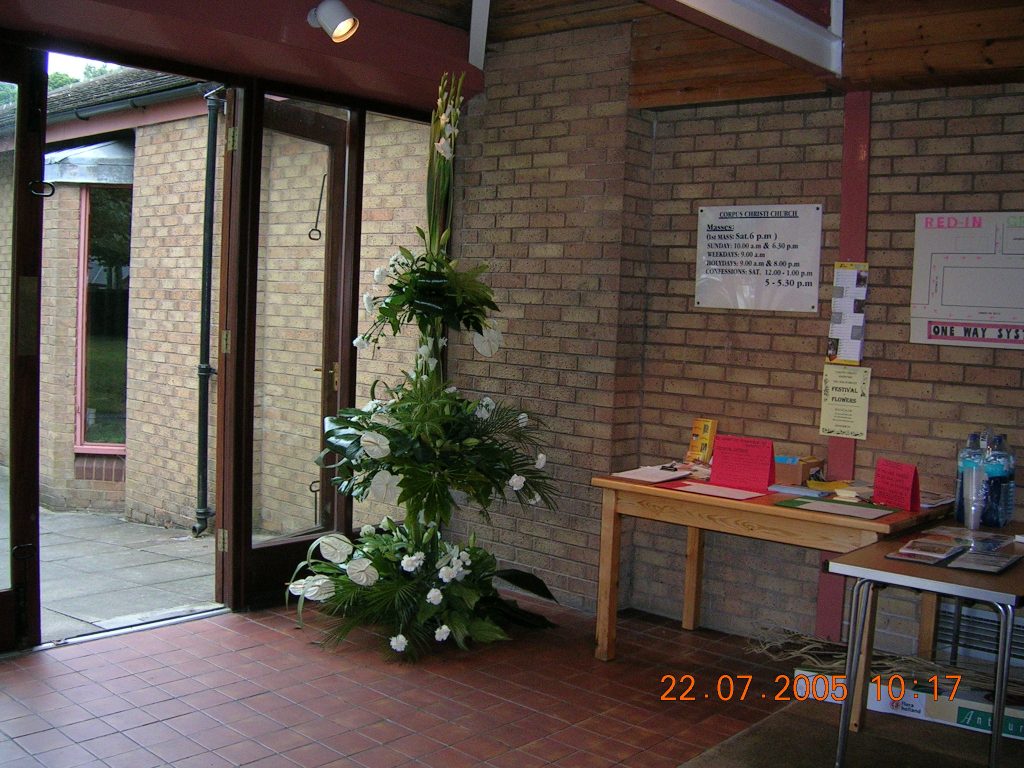
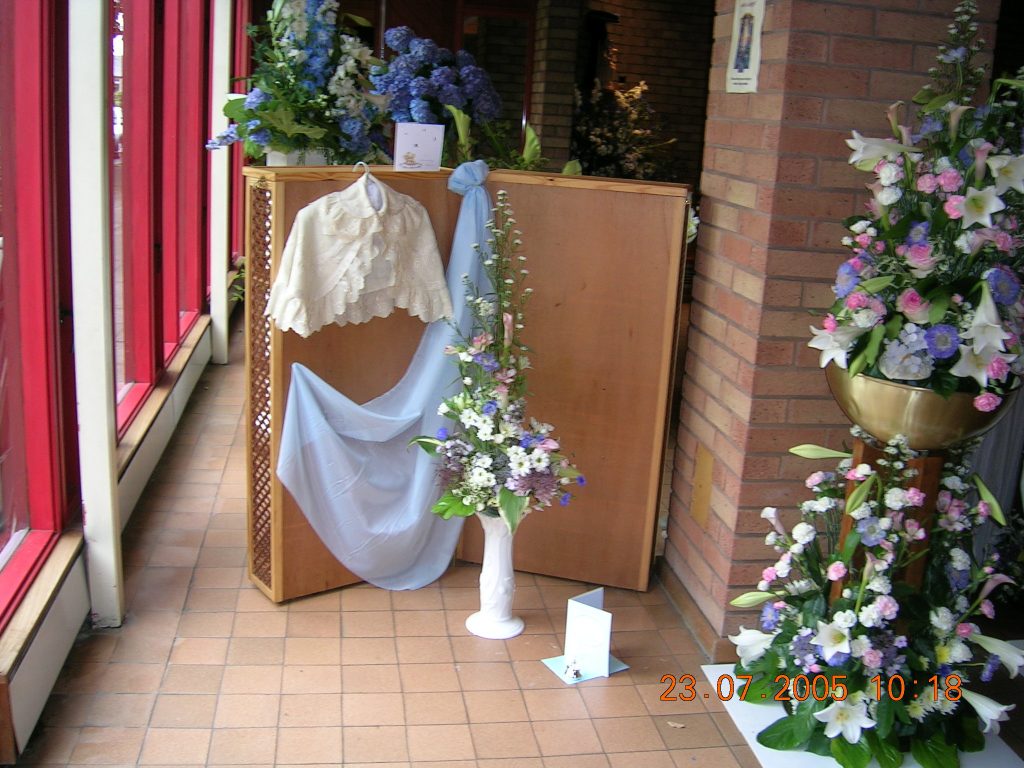
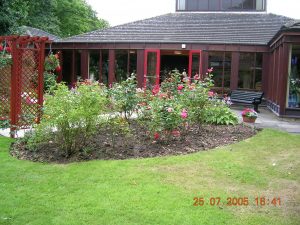
UNITED REFORMED CHURCH
Formerly
RAINFORD CONGREGATIONAL CHURCH
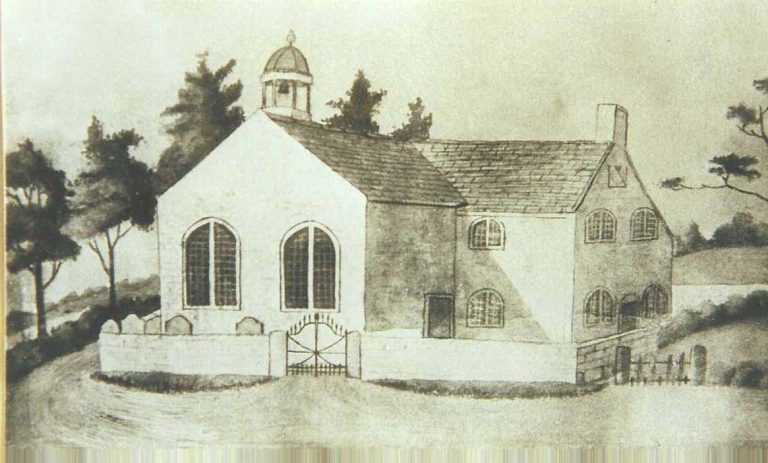
THE OLD CHURCH
From 1583 Rainford Chapel had been served by Puritan ministers until about 1640 when the Presbyterians gained control. Although nominally a chapel-of-ease they, and later non-conformist ministers, were tolerated by the Established Church of England authorities at the mother church at Prescot.
In 1689 an Act of Parliament required the meeting places of Protestants dissenting from the Church of England to be recorded and James Bradshaw, the then minister, applied to the Court for Rainford Chapel to be so recorded. Possibly foreseeing the Established Church regaining control of the Chapel Bradshaw also recorded his own house in 1697. When he died in 1702 the Dissenters were forced out of the Chapel and they recorded Heaton House as a meeting place in October of that year.
A site had been purchased on Higher Lane and a small chapel erected there by August 1706. Mr Bradshaw’s successor, the Reverend Renald Tetlaw, recorded this building as a meeting place in the following October. This plain, whitewashed building remained as a place of worship for the Independents for the next 170 years during which time it had the services of only four ministers.
The last of these four ministers was the Reverend James Widdows who came to Rainford in 1838. On the 23rd April 1867 he laid the foundation stone of a new church to be built on land adjacent to the old chapel. Built of local stone, with a handsome tower 58ft high the gift of Mr Richard Pennington of Muncaster Hall, the opening service of the new Congregational Church was held on the 23rd October that same year.
Standing on the high ground above the village this building still occupies a prominent position, both in the landscape and in the lives of its congregation.
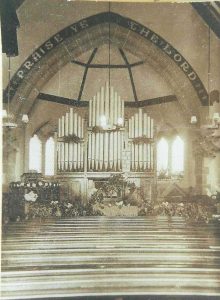
NEW ORGAN 1881
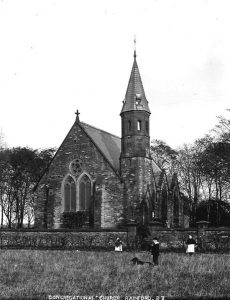
EARLY PHOTOGRAPH OF THE CHURCH
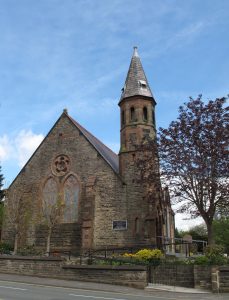
NEW CHURCH
FESTIVAL OF FLOWERS JULY 2003
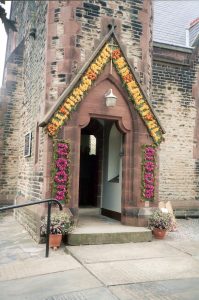

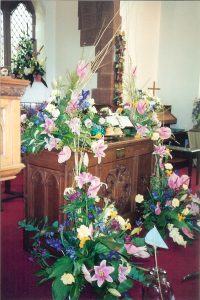
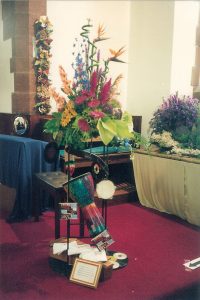
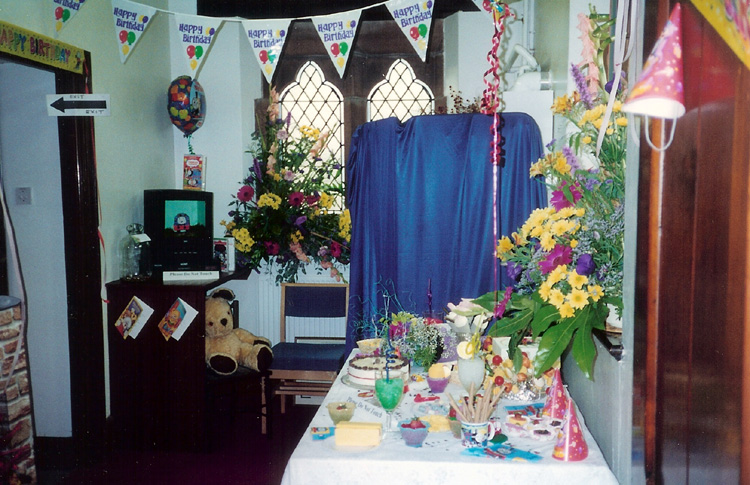
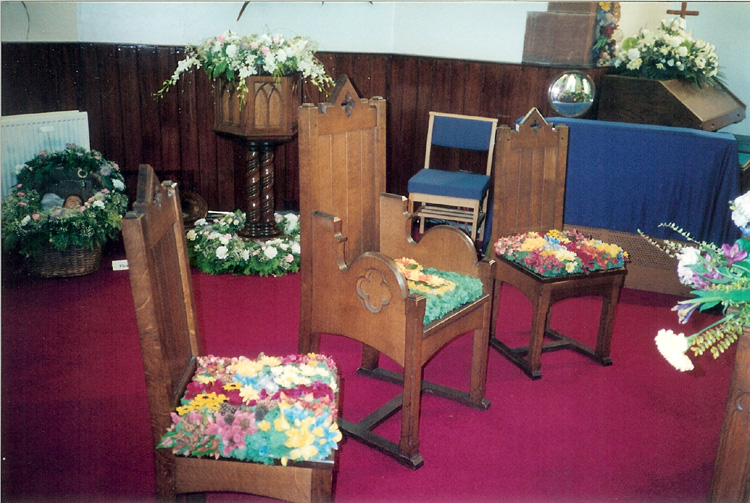
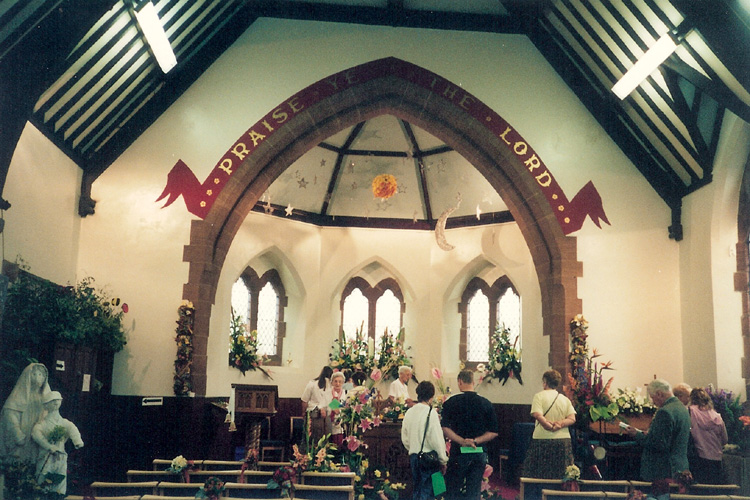
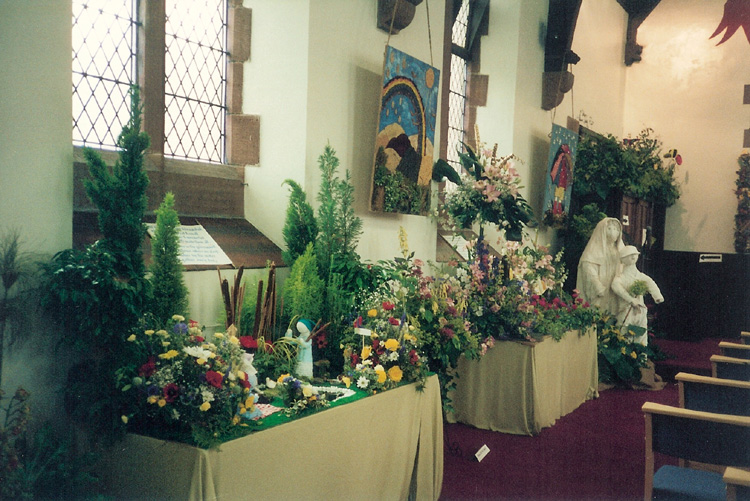
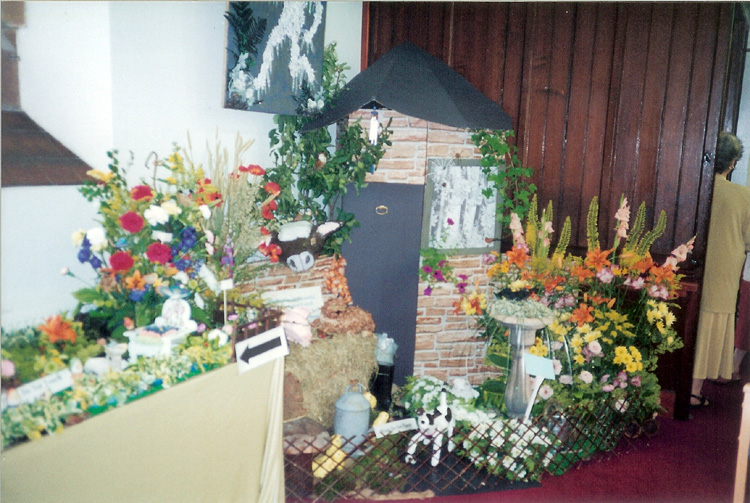
ALL SAINTS CHURCH RAINFORD
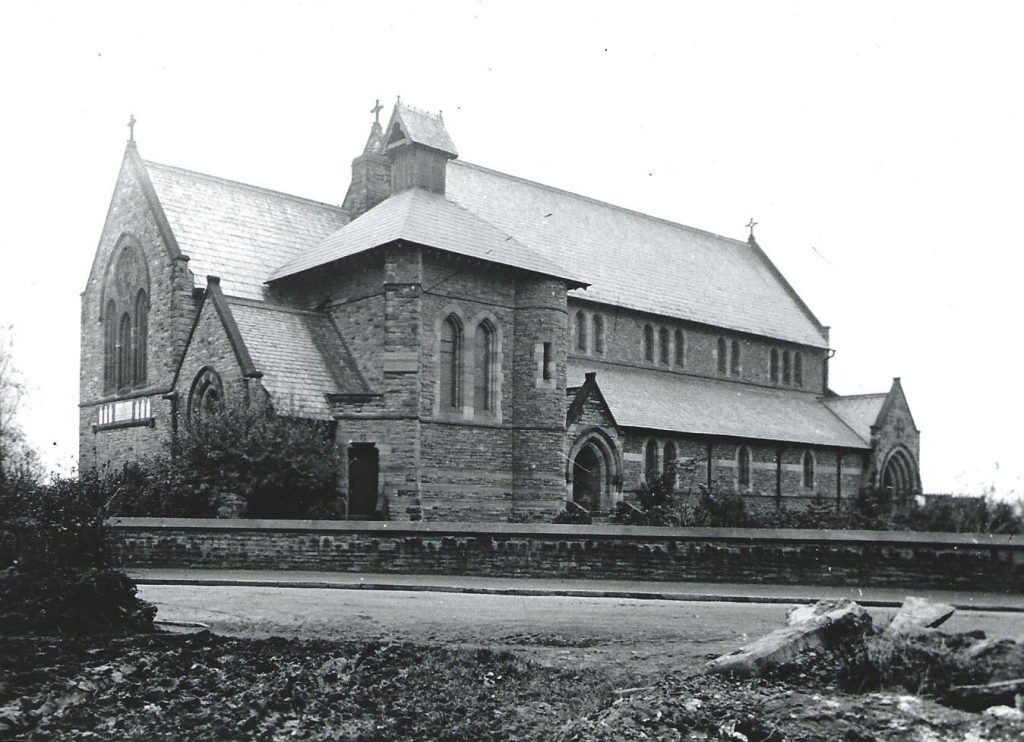
THE ORIGINAL ORGAN
The original organ, installed soon after the church was built, was first played on 1st February 1893. Built by Wilkinsons of Kendal at a cost of £600 it was housed in what is now the choir vestry behind the organ pipes and was hand blown by bellows. The blowing was electrified in 1947 and in 1962 the console was moved into the side chapel. In 1982 it was replaced by a Westminster, three manual, electronic organ.
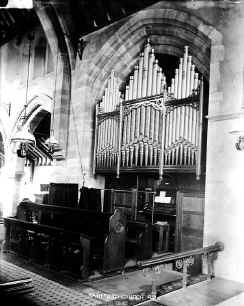
A NEW CHURCH FOR RAINFORD
It was not until 1869 that Rainford became a Parish in its own right, served by a Vicar instead of a Curate. Samuel Cavan became the first Vicar and on his retirement in 1873 he was succeeded by Gilbert Coventry Master , a young man of 34 with a wife and 3 – year – old daughter. Revd Master inherited a chapel which was in a poor state of repair and inadequate for a rapidly increasing population and three years later in 1876 it was no better. A local newspaper contained the following description of the Chapel at that time :-
“That the church was not likely to stand long; that one of the galleries had given way owing to the bulging of the wall, that they had only 17 free sittings for a population of about 3600. The need of a new church has long been felt as the present building, which is close upon 200 years old, is in a most wretched condition. The present building is inconvenient for both clergy and congregation alike. From the organist in his spiders-web sort of gallery to the Sunday school children crowded three deep in the main aisle in front of its fathom-wide curiously constructed chancel — from the minister in his cramped-up pulpit to the humble occupant of one of the free seats, all seems inconvenience and discomfort.”
Revd. Master realised that the Old Chapel was in urgent need of repairs which the parish did not have sufficient funds to carry out. He considered that the only alternative was to build a new church. This was a bold step for a vicar to take so soon after coming into the parish, but he realised that the scheme had little chance of getting off the ground unless some of the large land proprietors and property owners in the neighbourhood gave their support. Before announcing his plan he contacted Lord Derby who promised the sum of £2000 if the parishioners were able to raise the remainder of the sum required to build a new church.
Two issues remained to be settled. The question of a site for the new building and how were they going to raise the rest of the money was still to be decided. At first the Vicar had thought there was a chance of having the site of the Old Chapel but had found that this would necessitate digging into a large number of graves which he did not wish to be done. He had hoped that they could manage to find another site, ideally adjoining to the Chapel graveyard.
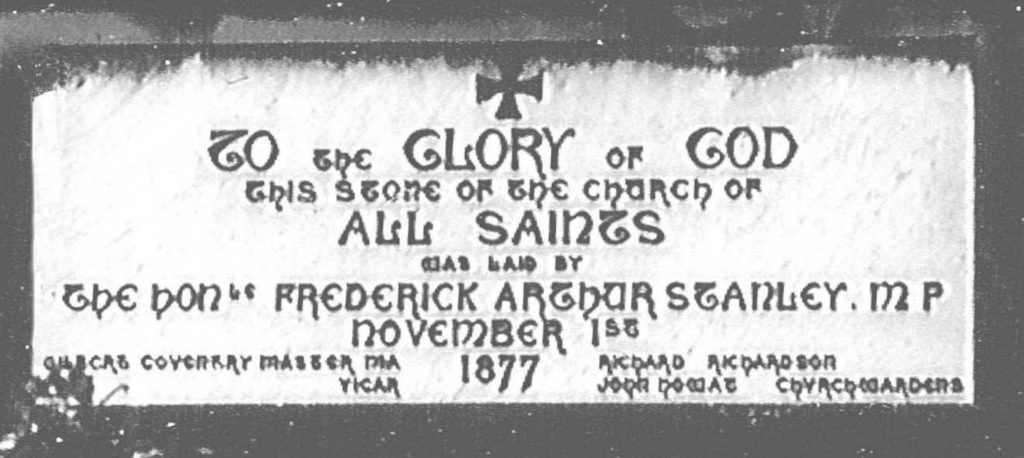
THE ALTAR
As no written record of its origin survives, the two old photographs suggest it is as old as the church.
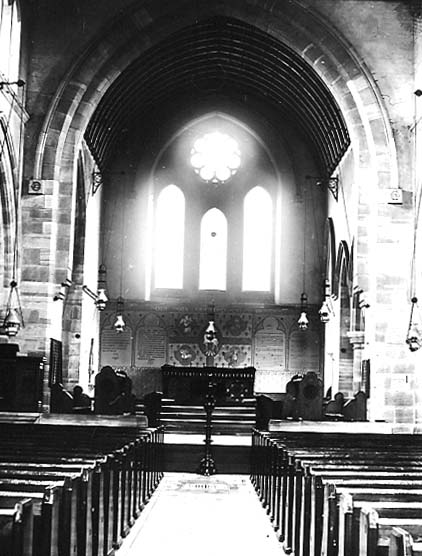
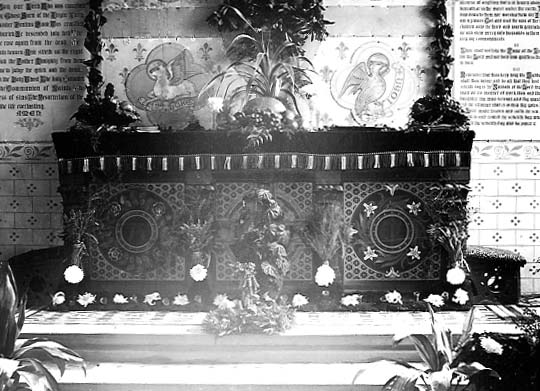
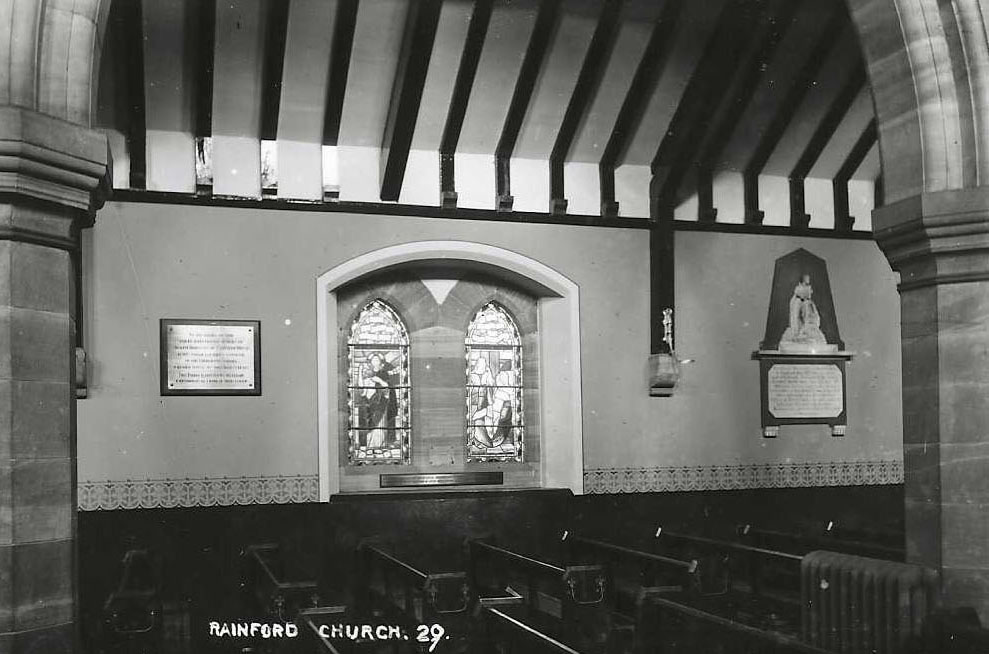
After much consideration it was agreed to demolish ‘The Old Golden Lion Inn’ which stood approximately where the church now stands. With the support of his congregation, great efforts of fund raising, a generous donation of £2000 by Lord Derby and numerous public subscriptions, work commenced in April 1877 on the building of a new church a few yards south of the old Chapel.
The work was soon completed at a total cost of £7027 (but without the tower which was added in 1903), and a Service of Consecration was held on All Saints Day 1878. With a fine new building and free seating for 550 persons the old chapel which had stood for over 300 years was finally demolished.
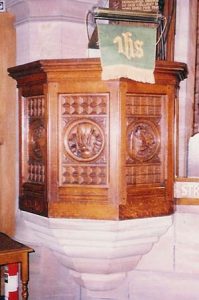
THE PULPIT
Carved in Oak by Harry Hems of Exeter depicting the symbols of Mathew, Mark, Luke and John and the Holy Spirit in the form of a dove. Costing 14 guineas it was the gift to the new church by the Sunday School Scholars.

THE ALTAR
THE LECTERN
This brass Lectern was given in 1878 by the Rev. William Fyles.
The son of George and Ann Fyles, he was born in Rainford in February 1849.
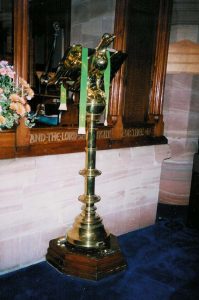
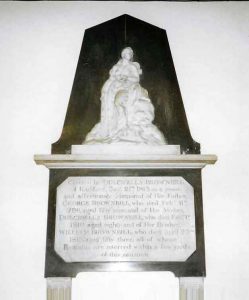
THE MABLE TABLET
Possibly the work of the sculptor John Gibson (1790-1866) who came from North Wales to Liverpool and was apprenticed to S & T Franceys of Brownlow Hill. He worked for them from c1812 until 1817 and then went to Rome for training in classical sculpture. Although bearing the name of Franceys it is not certain that this was the work of Gibson as it is not recorded in the documents of this firm.
Representing Hope Originally erected in the Old Chapel in 1813 by Dulcibella Brownbill. She was orphaned at the age of 14 when her father George died in 1786 but she was left £1000 in her father’s will. George, and his father Joseph before him, were malsters & brewers at what is now the Derby Arms.
Dulcibella’s sister Jane was already married to John Holden the school master of the private school at what is now the Golden Lion Inn. This was founded by his father Richard who came here from his school in Castle Street, Liverpool. John was appointed as guardian to Dulcibella and charged with her upbringing and education. She remained a spinster until her death in 1826 aged 55.
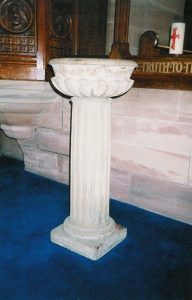
THE OLD STONE FONT
The Old Stone Font – originally from the Old Chapel it is inscribed with the name of Henry Moore and dated 1723-4. Henry was Chapel Warden.
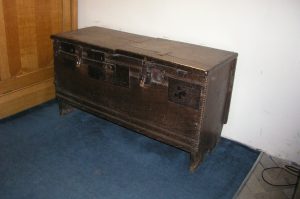
Originally from the Old Chapel it is dated 1765, and bears the initials J.F. John Files was churchwarden in 1764-5
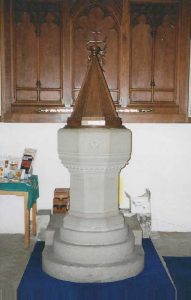
THE NEW STONE FONT
The New Font – built as part of the original contract, the gift of one John Prescot of Dalton Grange, but it has not been used for some time as recent vicars have preferred to use the old font at the front of the church.
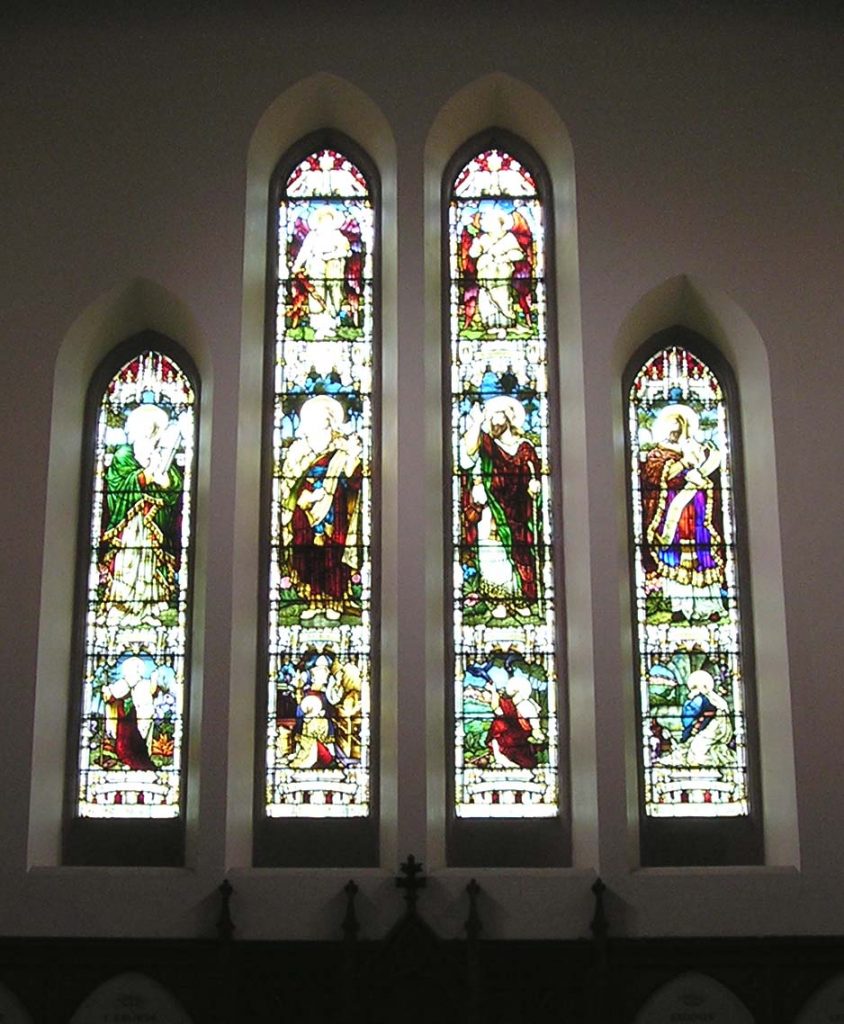
THE WEST WINDOW
Moses, Samuel, Elijah & David; St Michael & St Gabriel 1906, in memory of Joseph Robinson of Fairfield House, Crank. This was the gift of the St Helens Brewers Greenall Whitley Ltd.
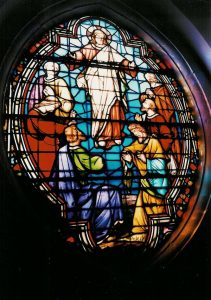
EAST WINDOW FROM THE OLD CHAPEL
During the course of building the new church it was decided to add an extra window to accommodate the stained glass which formed the upper part of the East window of the Old Chapel. This beautiful stained glass window had been given in memory of the Foster family of Rainford. It can now be seen high on the west wall.
THE STAINED GLASS WINDOWS
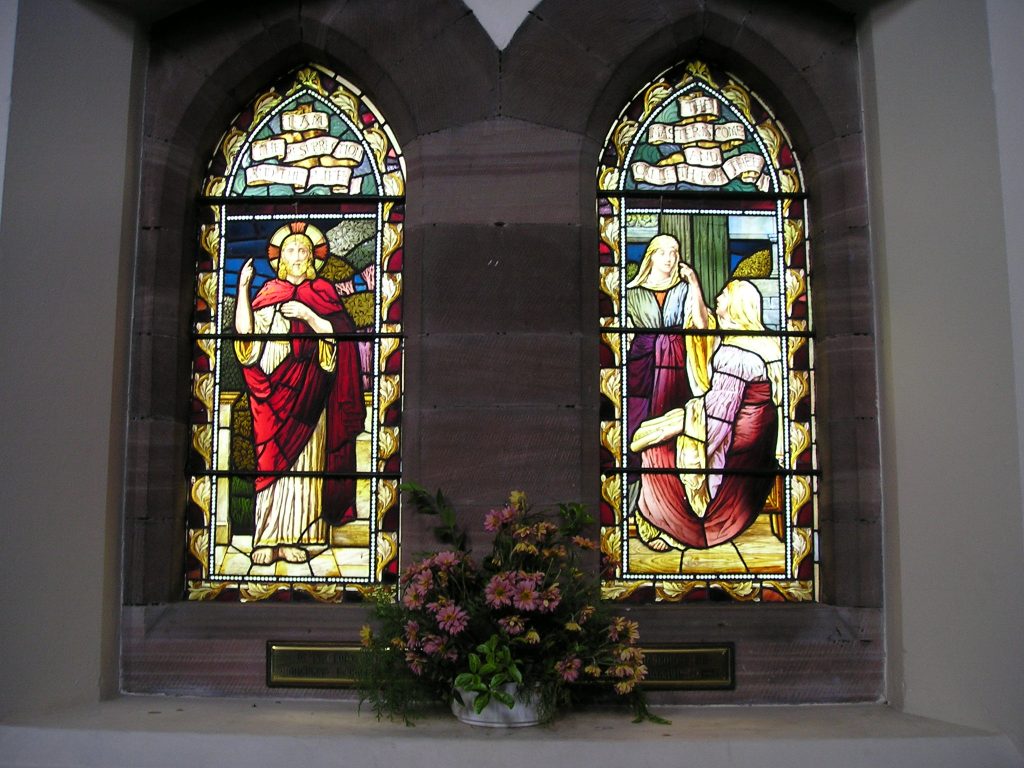
All the lower windows are now filled with stained glass. Each one has been donated to the church in memory of loved ones.
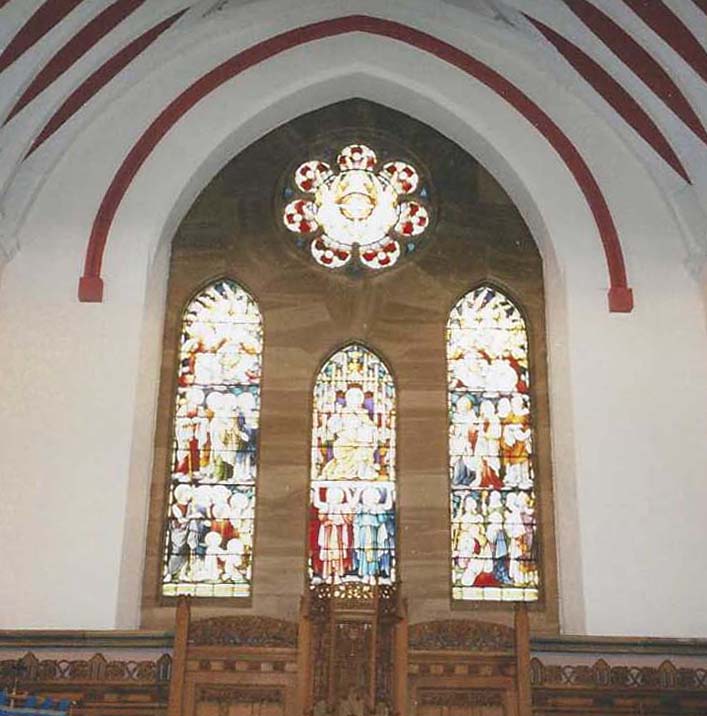
THE EAST WINDOW
Given in 1893 by Joseph Robinson in memory of his father Samuel Robinson. Samuel was a brewer and he was brought from Warrington in 1835 by Gilbert Greenall to manage his St. Helens Brewery which he did for 31 years. His son Joseph followed him in the trade and was one of the five original directors of Greenall Whitley Ltd.
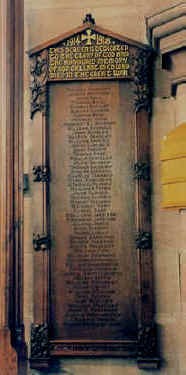
1914-1918
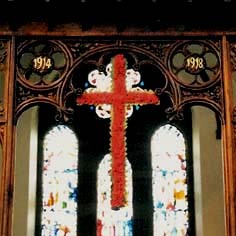
THE ROOD SCREEN- WAR MEMORIALS
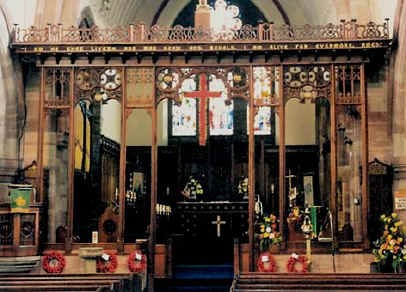
This beautiful oak screen was erected as the War Memorial in honour of the men of Rainford who gave their lives in the First World War. Parishioners contributed just over £600 to pay for it and on 2nd November, 1921, it was unveiled by Colonel Norman Pilkington, D.S.O. and dedicated by Bishop Chavasse of Liverpool.
‘We will Remember Them’
Two oak tablets placed on the pillars at each end of the screen record the names of seventy-two men from the First World War and thirty-six men from the Second World War.
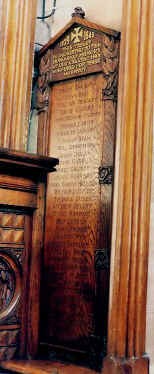
1939-1945
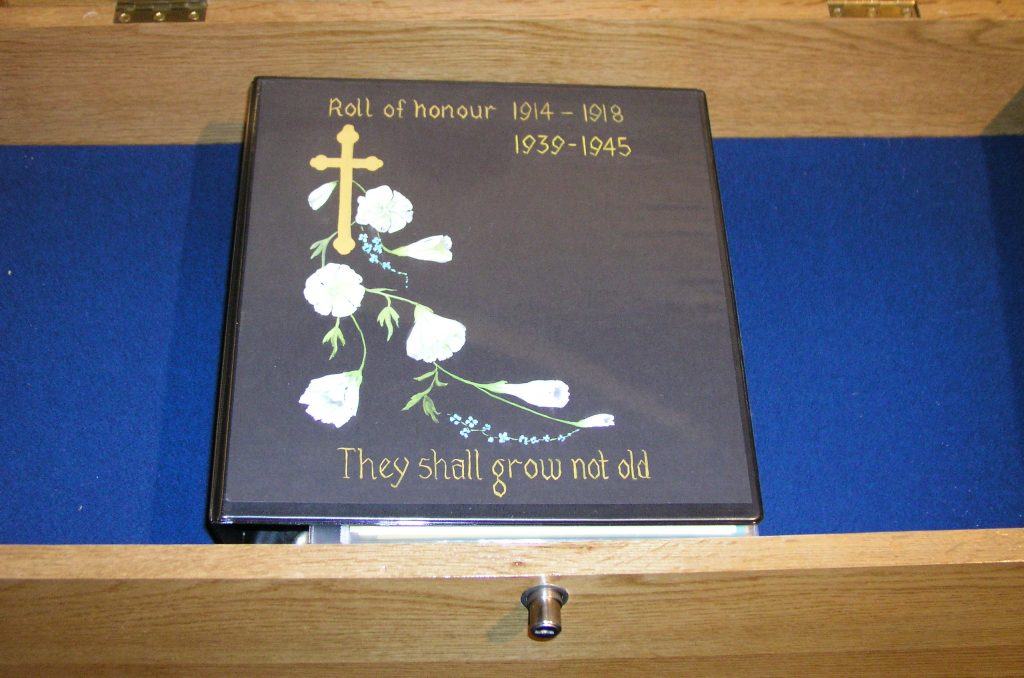
This book contains details of family and military records, along with some photographs, of all the men who gave their lives in the First and Second World Wars. It is housed in an oak cabinet in church and was dedicated at the Service of Remembrance, November 12th, 2000.
THE BUILDING OF THE TOWER
In 1902, it was suggested that completing the Tower would be a suitable way to mark the coronation of King Edward VII but little did anyone believe that this could be achieved by October 31st, the following year. On Sunday December 7th, Canon Bridger announced in Church that the estimated cost of £1500 had been received by kind donations. Five hundred pounds from Lord Derby, and a thousand pounds from Mr Joseph Williams, of Waterloo, as a fitting memorial to his friend Mr. Richard Manley Foster who had recently been buried in the graveyard.
The Vicar also called a public meeting of the parishioners for the following evening in which a committee was formed to decide how to raise sufficient money to include a clock and peal of bells. To achieve this a list of promised subscriptions was opened
The committee then met again shortly afterwards, and it was decided to ask Mr Deacon of Liverpool, the architect who had designed the Church, to submit plans which included a Tower or Spire with room for six bells and two clock dials. In the meantime, the parishioners were beginning to feel that the Church should have a full peal of eight bells, and of course this could only be achieved if more money was raised.
As the list of promised subscriptions was steadily growing, it was agreed that there would be a sufficient amount for eight bells and four clock dials.
When Mr. Williams paid a visit to see how the work was progressing, he expressed his wish that the Tower should not have a spire.
By July 1903, Messrs. Taylors of Loughborough had cast the bells and on the Tenor Bell was inscribed, ‘These eight Bells were given to the Glory of God by the people of Rainford’. An appeal was now made for men to come forward to learn the art and skills of bell ringing and this received a good response.
In August, the bells had been heard and declared to have an excellent peal. The four dials for the clock had been received and were soon to be placed in position. The clock having been made by the great firm of railway clock makers, Messrs. J. B. Joyce, of Whitchurch, Shropshire, was an eight day one and was to strike each hour on the tenor bell. It was also hoped that by the end of September the Bells would be hung, enabling practices to begin early in October, so that all would be ready for the dedication service which was to be held on Saturday, October 31st..
Due to an accident the Bishop of Liverpool, Dr. Chavasse, was unable to attend the service as promised, so it was conducted on his behalf by Bishop Royston, assisted by many other clergymen from neighbouring churches. The church was full but the bells could only be chimed at various times throughout the afternoon.
The following day, being ‘All Saints Day’ and the 25th Anniversary of the consecration of the Church, three further services were held.
In the morning Canon Mitchell, of Prescot, preached to a crowded congregation an inspiring sermon on “Words”. In the afternoon the Friendly Societies of the village walked in procession to Church, headed by the Moss Bank Brass Band and here the Vicar, Canon Bridger, preached to yet another full church, with large numbers being unable to get in
The Vicar was very moved by this, and during the service he thanked the parishioners and all those who had in any way contributed to the completion of this beautiful church. The band accompanied two of the hymns, and played “The heavens are telling” as an out-going voluntary.
Then at night to yet another full church, the Rev. Canon Willink preached about the love Rainford people had for their church, and about the good feeling that existed in the parish between the Vicar and his people.
Even though the bells had been hung and were ready for the dedication service, the architect, builder and bell founder all said they thought it would be better if we didn’t ring them for a few months until the stone work of the Tower was properly dry. But they did all agree that in the meantime they could be chimed, which is what happened on special occasions until May 1904. Then, James Pilkington, the builder, said he thought the stonework was dry, and that the mortar was, “as hard as a rock”. Everyone agreed, so the bell founders came from Loughborough to fix the ropes ready for the opening ceremony.
This took place on Saturday, May 14th, 1904. The Vicar, churchwardens and other church officials were there to meet ringers who had come mainly from Wigan Parish Church accompanied by a few from other churches that had bells. To start with they all inspected the bells, and then they raised them ready to start ringing
First of all they rang several different changes, Queens, Tittums, Fire, and Grandsire triples, and then, along with the Rainford ringers, they all went to the Golden Lion for their tea which was provided by Mr.Joseph Robinson of Crank,
After tea Thomas Halliwell, one of the conductors, thanked everyone for their kind generosity and gave a few words of encouragement to the Rainford ringers before going back to the Tower to ring several more touches. Everyone said the bells had a magnificent tone. The following day, some of the ringers came back again to ring for morning and evening services, as well as Bible class in the afternoon
Having heard the bells being rung so well, it made the Rainford ringers want to practice harder, perhaps even more so after they heard the first full peal rung on the new bells on August 6th, 1904, by members of the Liverpool Diocesan Guild, along with some of the Wigan members. A few weeks later on Sunday, August 27th, they managed to ring all 8 bells for the first time and at the Harvest Festival service in September, the Vicar complimented them on how well they were doing.
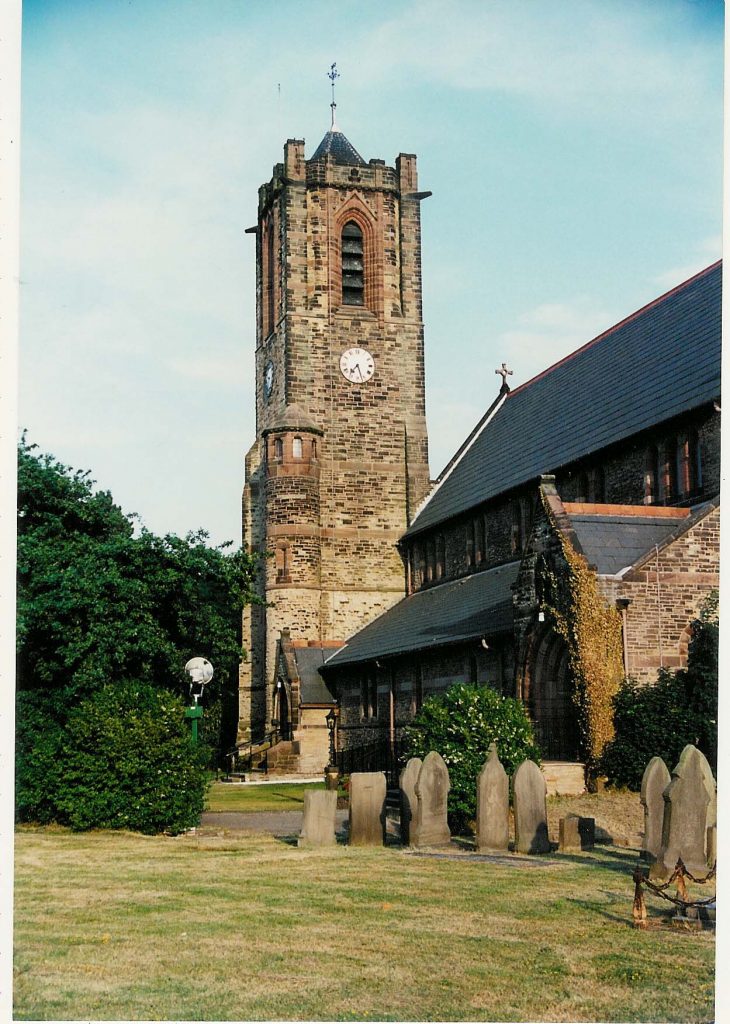
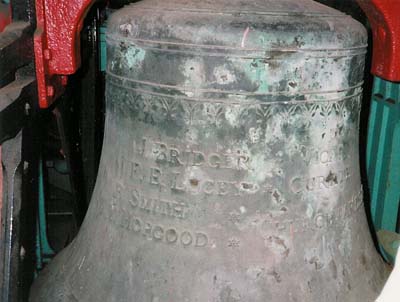
J. BRIDGER, VICAR
F.E.LACEY, CURATE
B.SMITH, J.T.HOPGOOD
CHURCHWARDENS
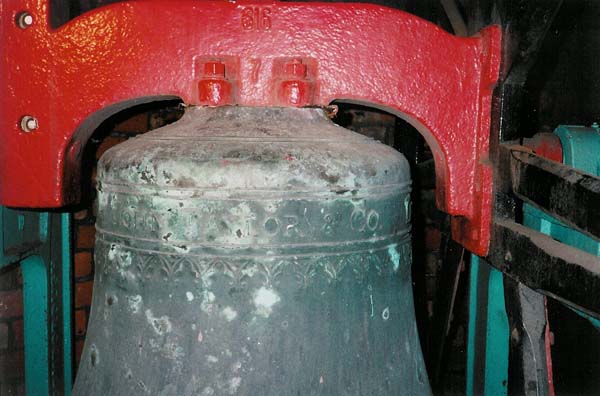
Taylor & Co. Loughborough
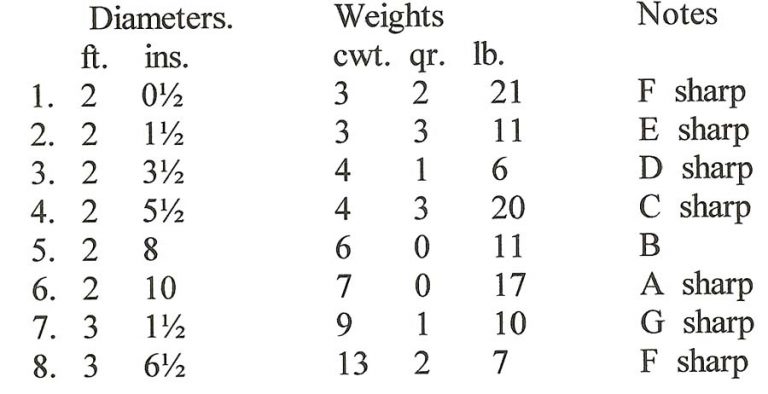
Table showing the Diameters, Weights and Notes of the Bells
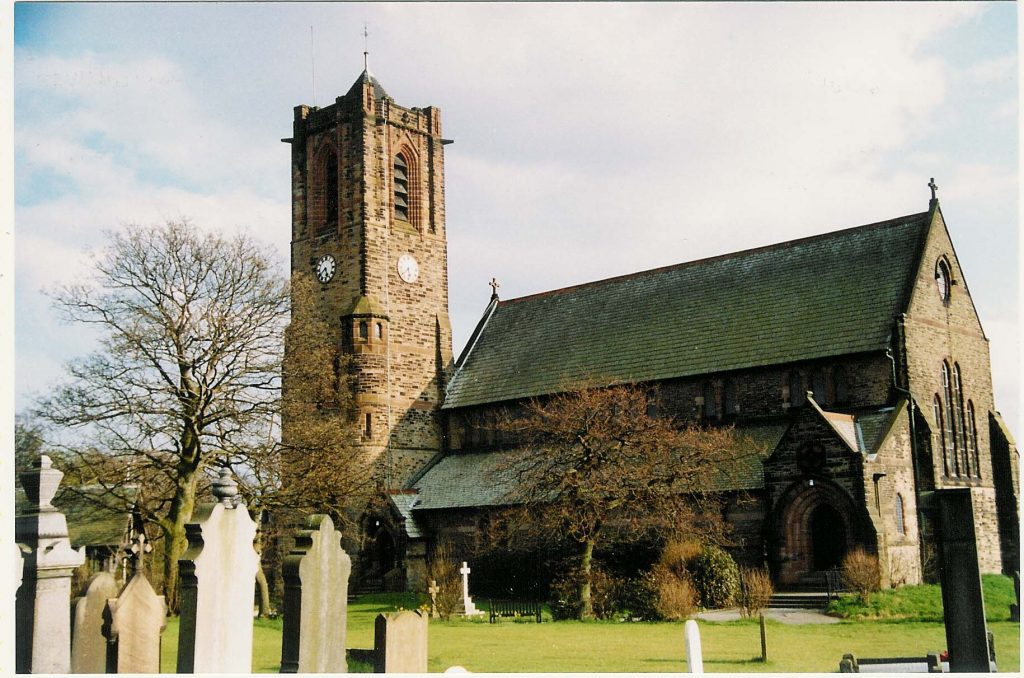
When the church was first built in 1878, funds were insufficient to include the Tower. It wasn’t until 1903 that the building was finally completed by the addition of the Tower, which included a clock and a peal of 8 Bells.
On November 18th, 1909, an all Rainford band of ringers rang their first half peal of Holt’s Part Peal Grandsire Triples, 2520 changes in 1 hour 32 minutes, conducted by J.W.Hall, and their first full peal was rung on Thursday evening January 24th, 1929. This was a peal of 5040 changes of Grandsire Triples in 3 hours 9 minutes.
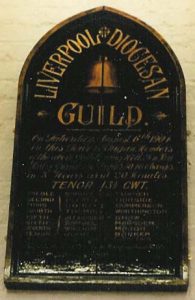
As seen on the above boards in the Ringing Chamber
First full peal was rung on the 6th August, 1904, by members of the Liverpool Diocesan Guild along with some Wigan members
Treble. Samuel C.C. Turner 2nd. Alfred Garside 3rd. John E. Gummerson 4th. Thomas Worthington Conducted by- | 5th. Alexander Shaw 6th. Samuel Marsden 7th. William Major Tenor. John Barker John E. Gummerson |
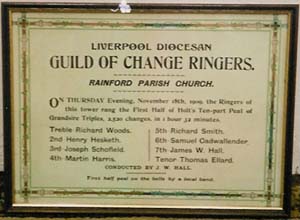
Liverpool Diocesan
GUILD OF CHANGE RINGERS RAINFORD PARISH CHURCH On Thursday Evening, November 18th, 1909,the Ringers of this tower rang the First Half of Holt’s Ten-part Peal of Grandsire Triples,
2,520 changes, in 1 hour 32 minutes.
1909
Treble. Richard Woods 5th. Richard Smith
2nd. Henry Hesketh 6th. Samuel Cadwallender
3rd. Joseph Schofield 7th. James W. Hall
4th. Martin Harris Tenor. Thomas Ellard
Conducted by James W. Hall
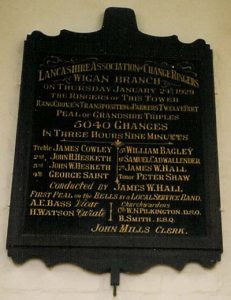
The first full peal was rung on Thursday evening January 24th, 1929. This was a peal of 5040 changes of Grandsire Triples in 3 hours 9 minutes
1929
Treble. James Cowley 5th. William Bagley
2nd. John H. Hesketh 6th. Samuel Cadwallender
3rd. John W. Hesketh 7th. James W. Hall
4th. George Saint Tenor. Peter Shaw
Conducted by James W. Hall
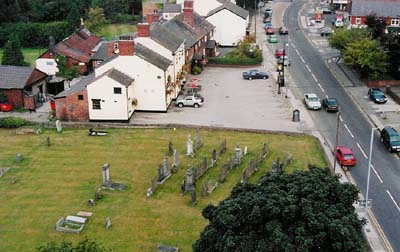
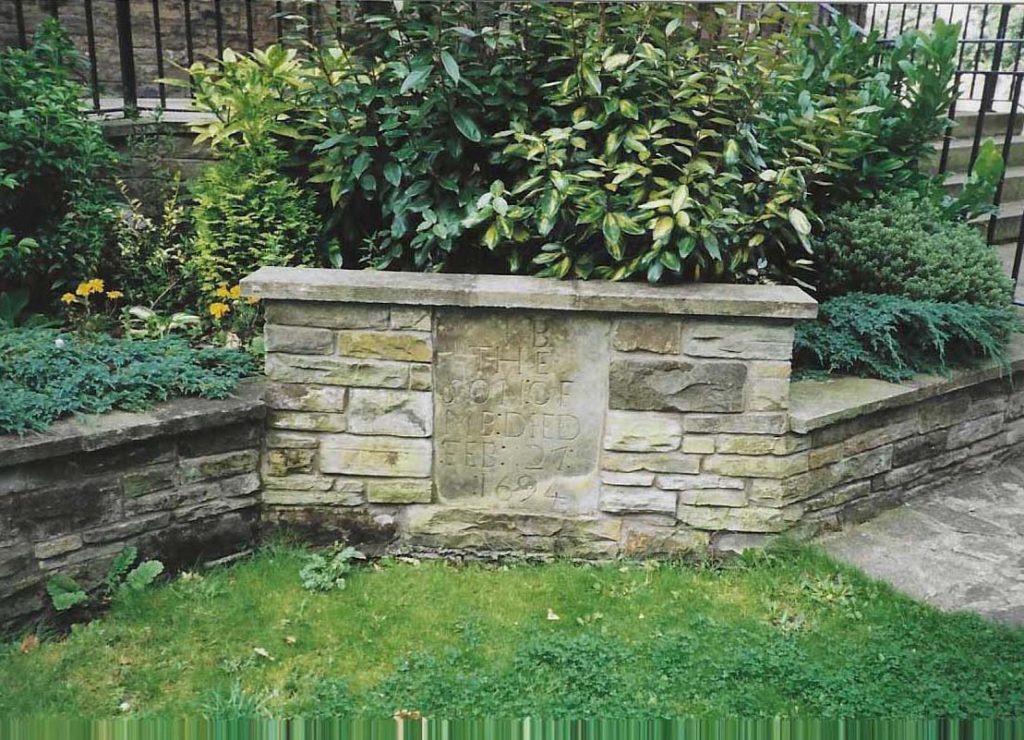
Oldest known headstone
THE CHURCHYARD
Early documents prove that throughout the years the churchyard has been extended at various times. The earliest one being the Sentence of Consecration of additional chapel yard in 1829, followed in 1861 by the Sentence of Consecration of additional church yard.
In this area of the churchyard, now referred to as Section 1, stood the old chapel which was demolished in 1880. In 1911, it was necessary to use the site of the old chapel to accommodate more graves and by 1914 when this area was almost full it became apparent further land would soon be
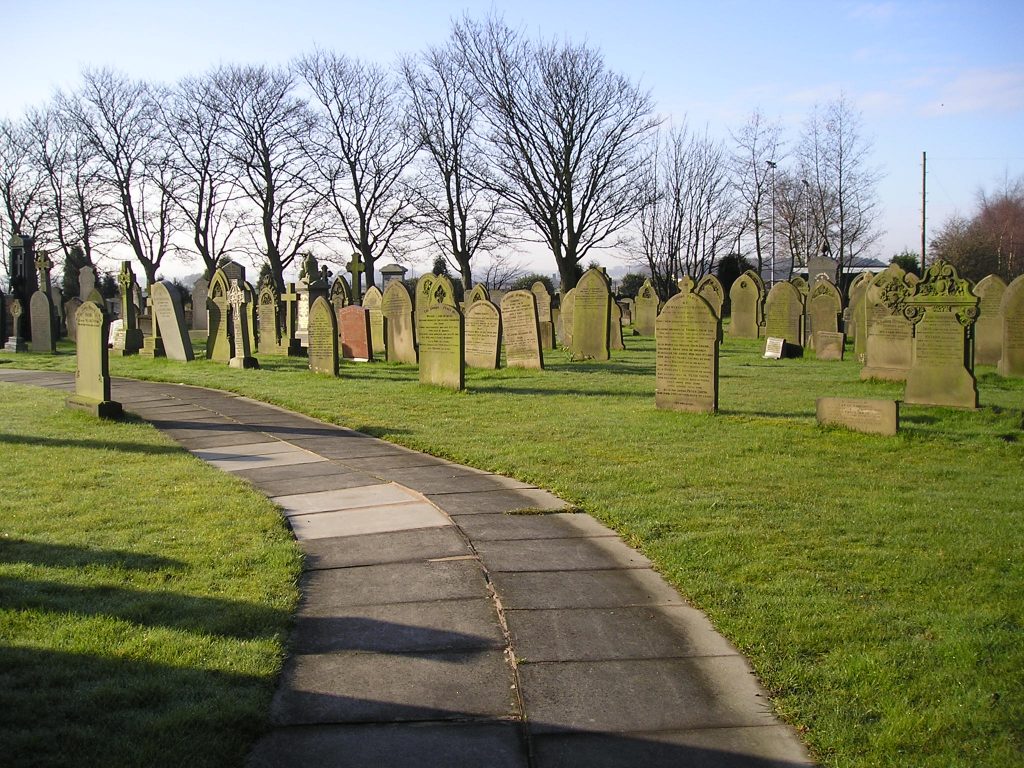
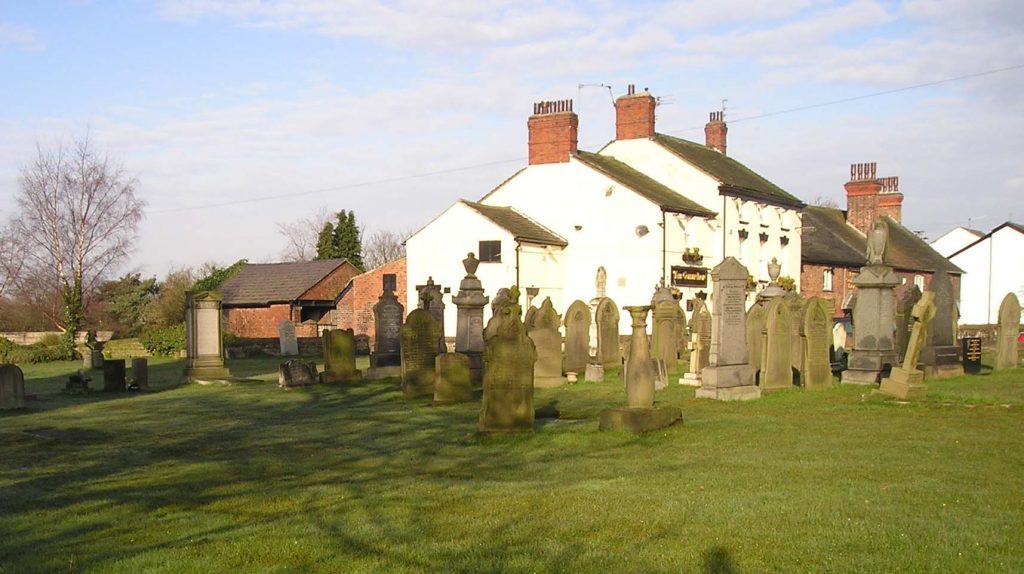
SECTION 1 – Area of Old Chapel
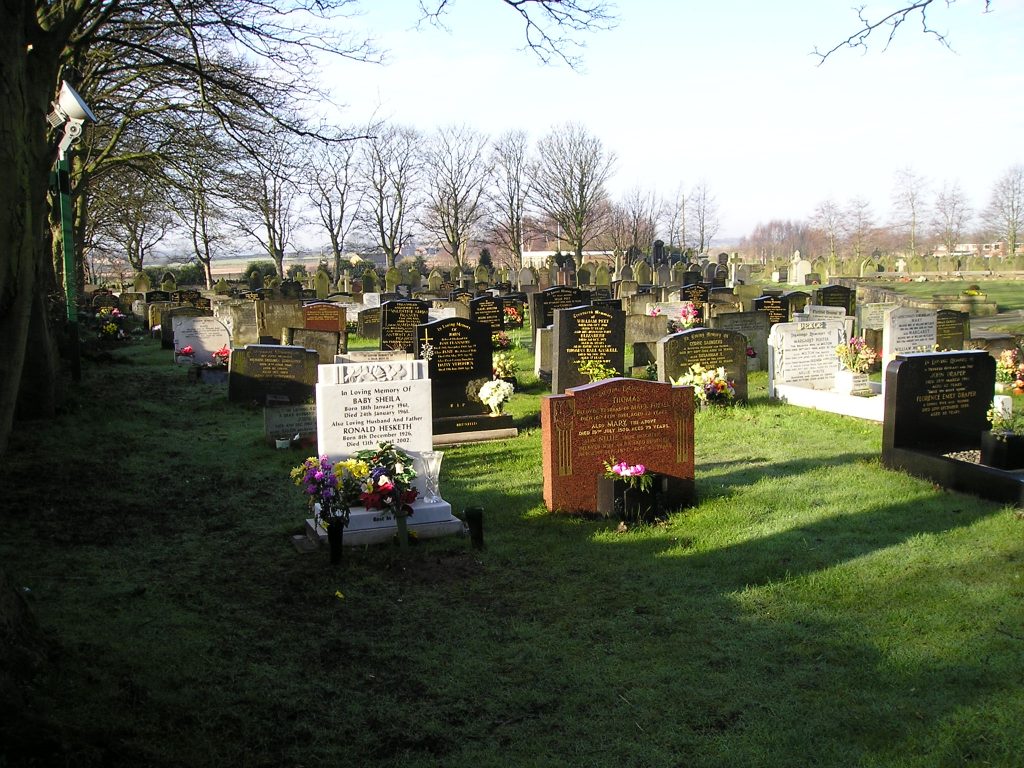
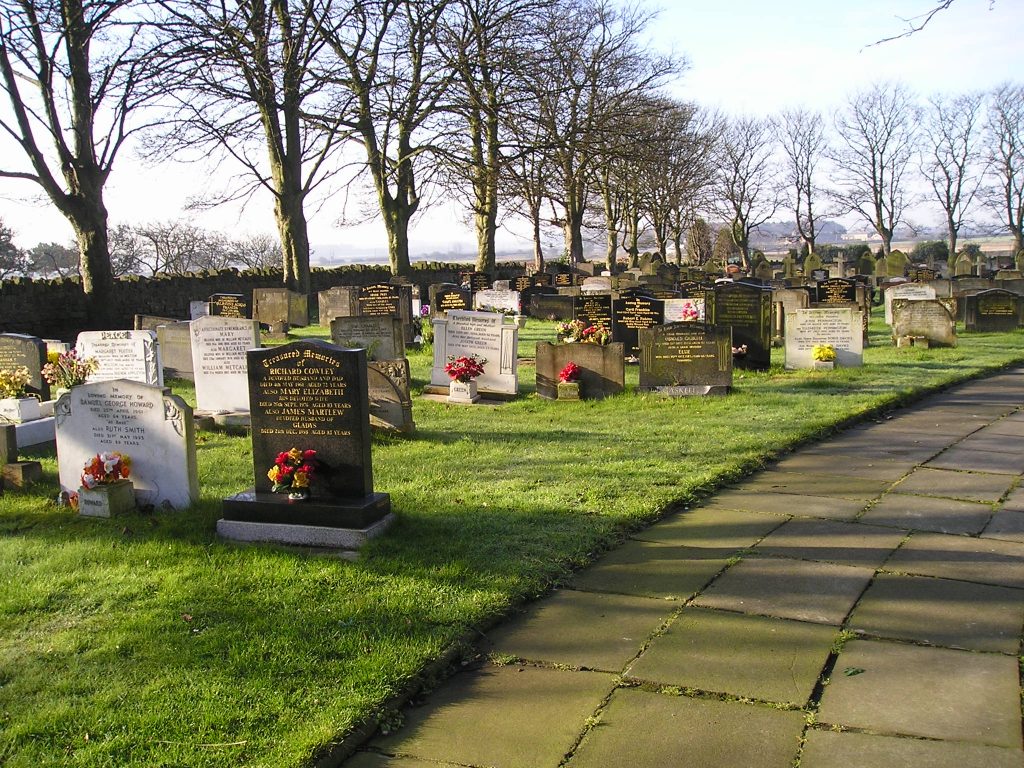
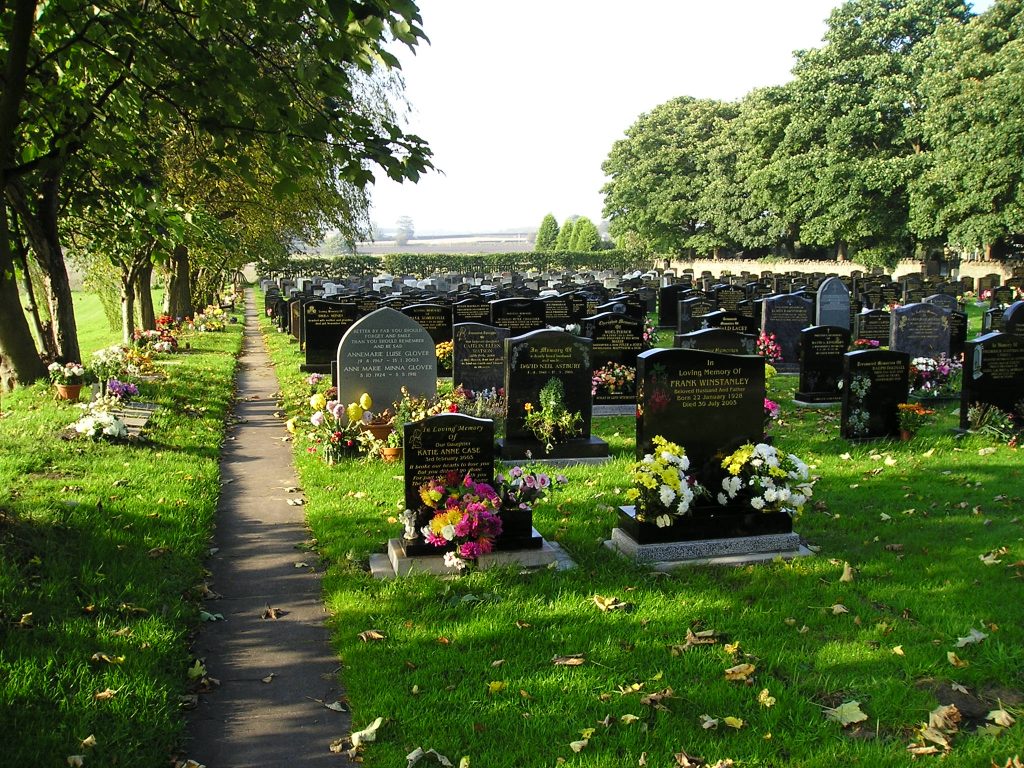

SECTION 2 OPENED 1916
This area of land lying on the south side of the new church was conveyed in 1914 and consecrated in 1915 for the use of an additional church yard. Divided by a path in the centre, the area lying to the west was used first with graves mainly dating from 1916 until 1946. To the east of the path, the graves date from 1946 until 1961.
Now known as Section 2, interments still continue in existing family graves.
SECTION 3 OPENED 1961
Still on the south side of the church, this land adjoining Section 2 was consecrated in 1961 and is known as Section 3. In 1932, Revd. A. E. Bass, Vicar of Rainford, purchased land from the Earl of Derby which was to provide sufficient burial plots for many years to come. The first half which is known as section 3 is now almost full, and the remainder is being prepared for use in the near future
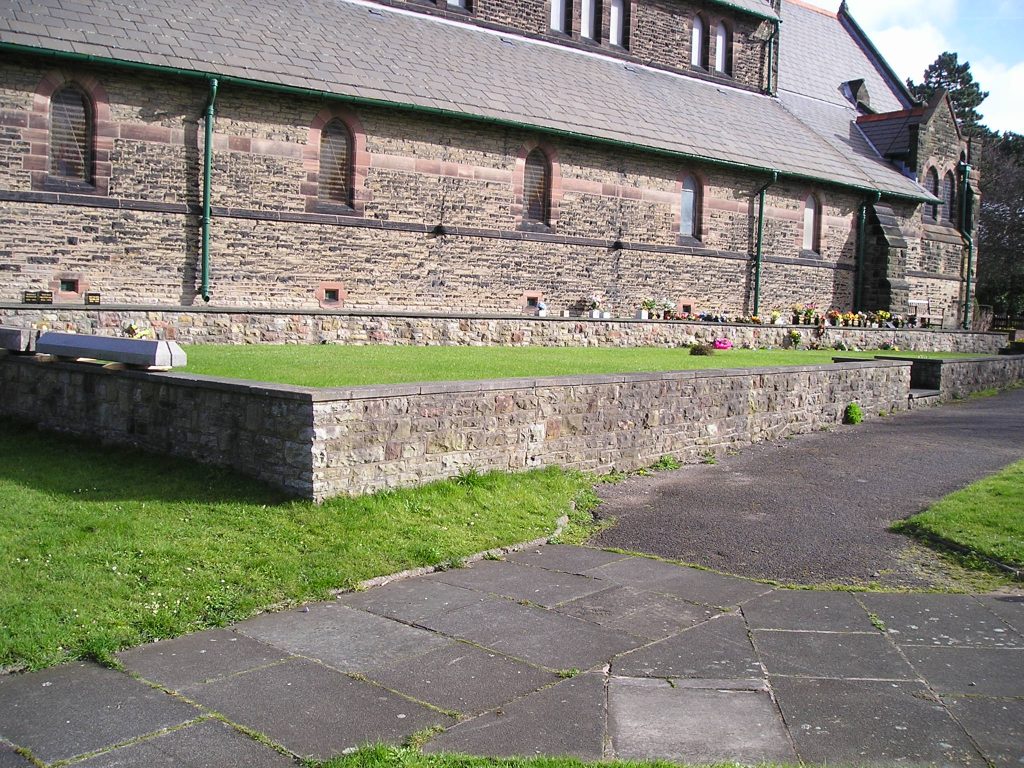
SECTION 2
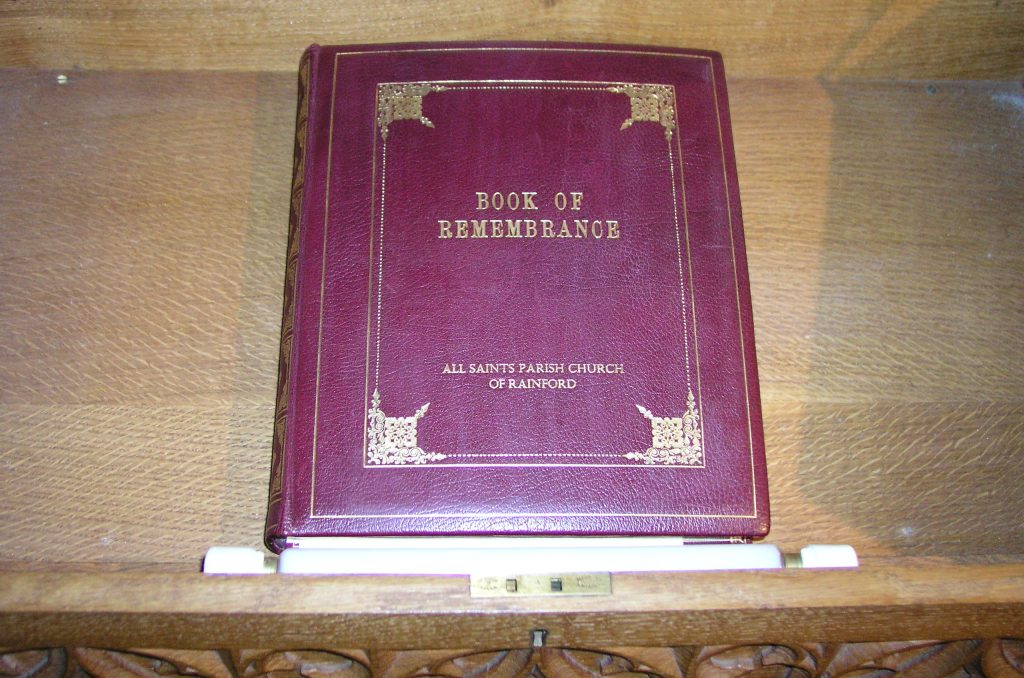
BOOK OF REMEMBRANCE
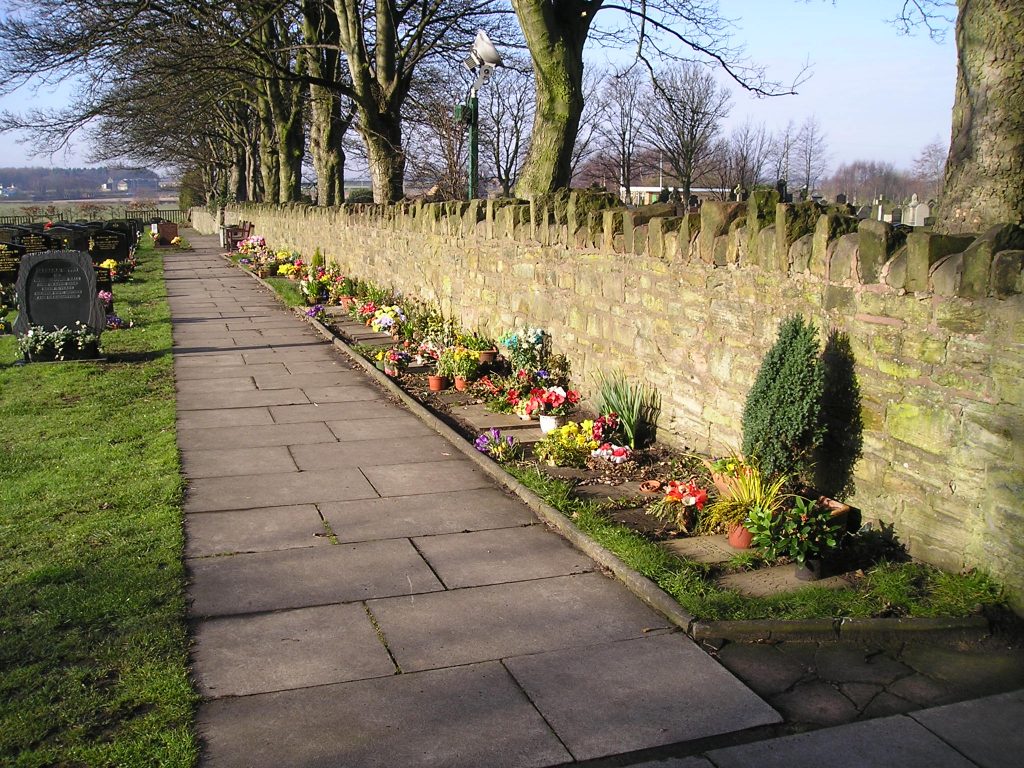
SECTION 3
The first Garden of Remembrance was opened in 1969 and the names of those whose cremated remains are interred there can be found in this book which is housed in an oak cabinet inside church. This garden can be found along the south side of the church in section 2.
A donation in memory of Mr. Leslie Alcock in 1993, allowed a new Garden of Remembrance to be prepared along the outer edges of section 3.
THE MILLENNIUM
A Festival of Celebrations
September 2000
A Flower Festival in Church
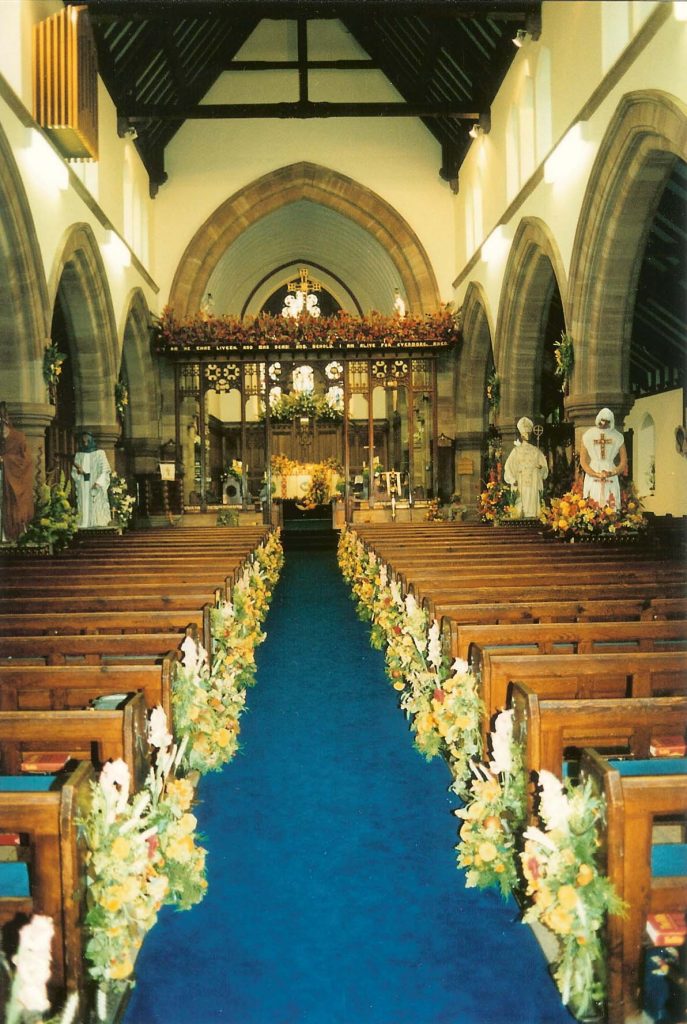
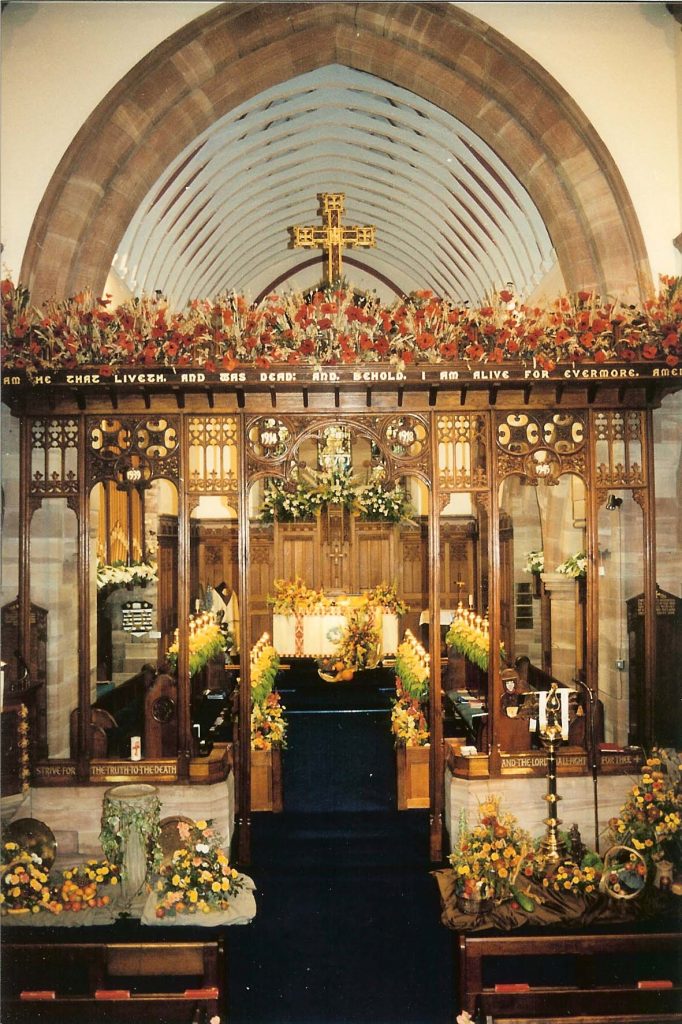

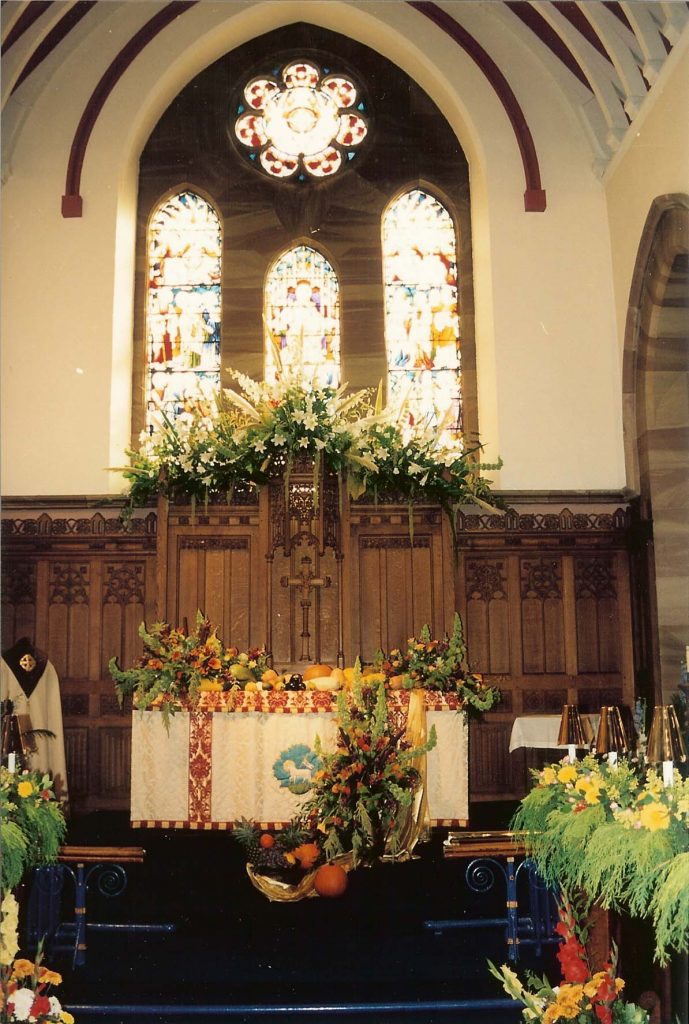
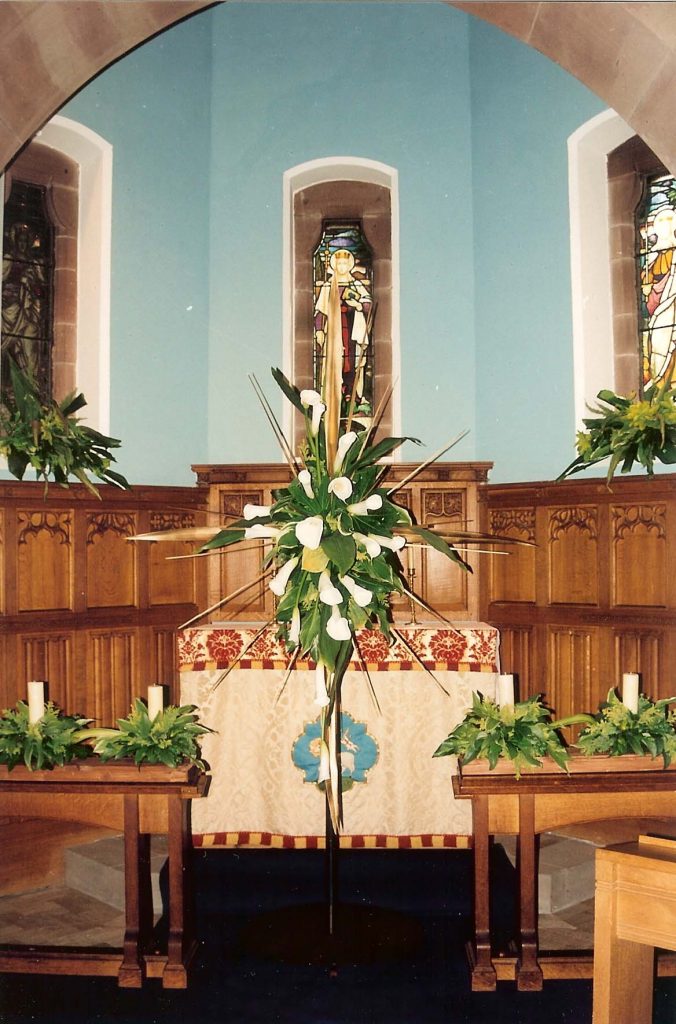
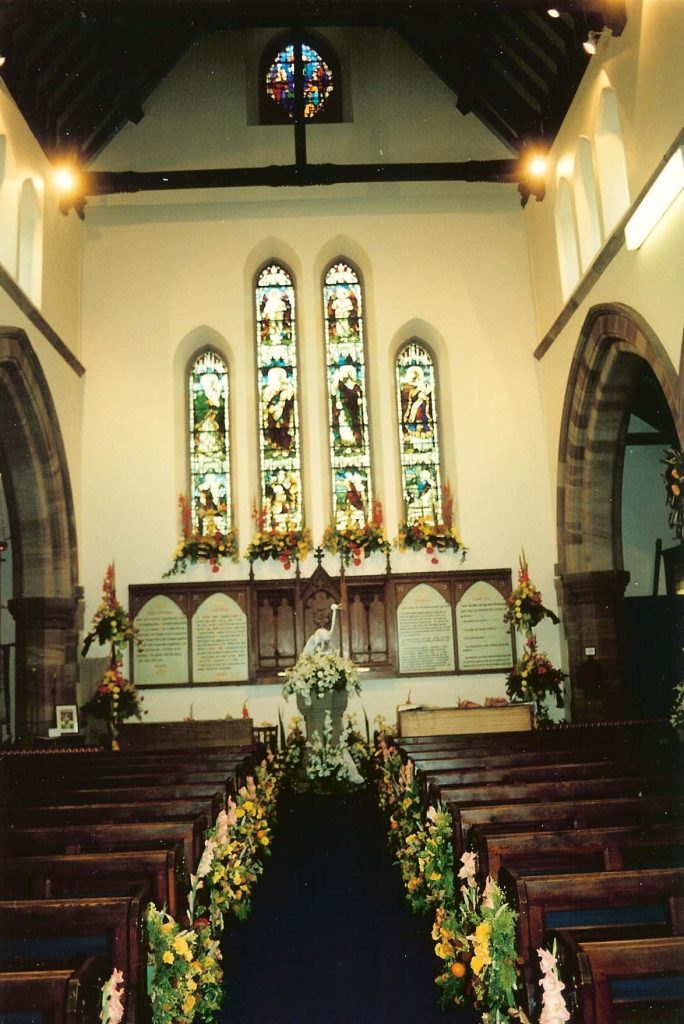
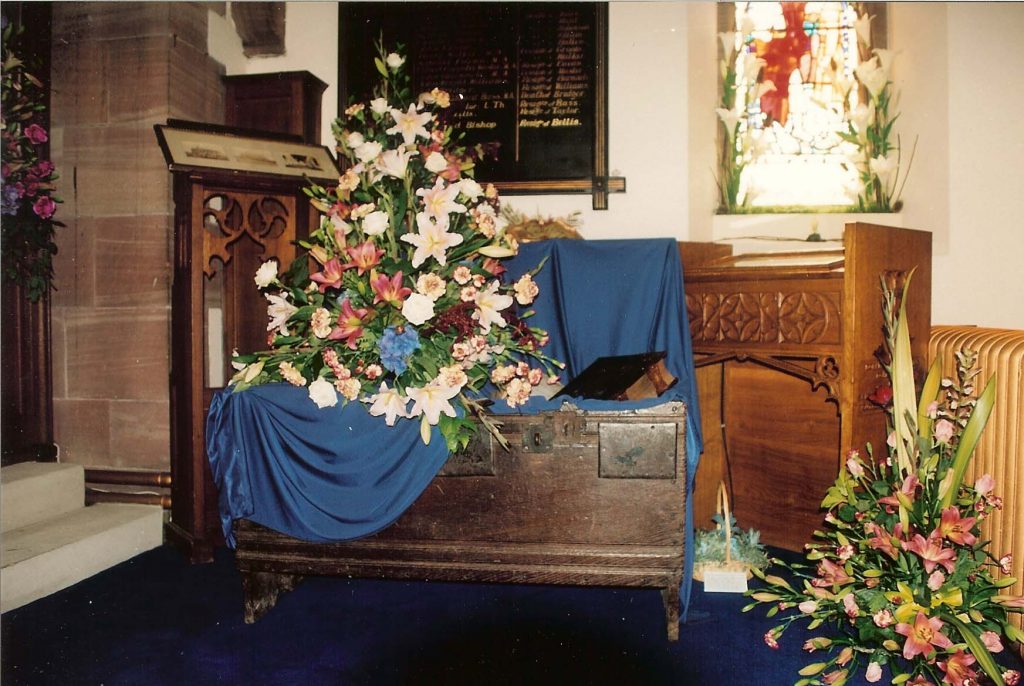

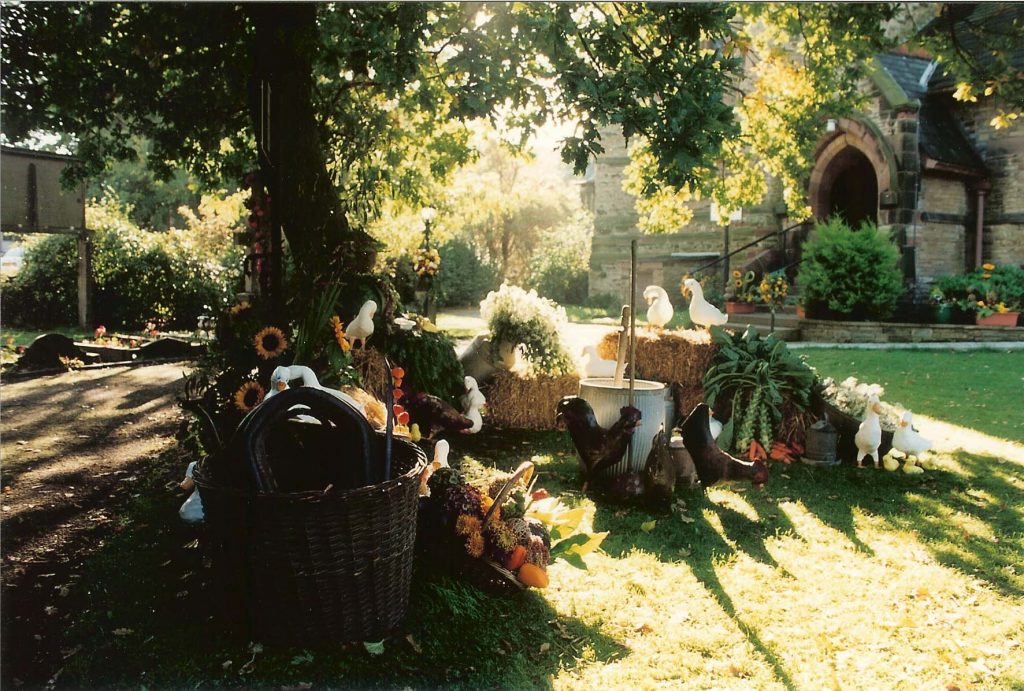
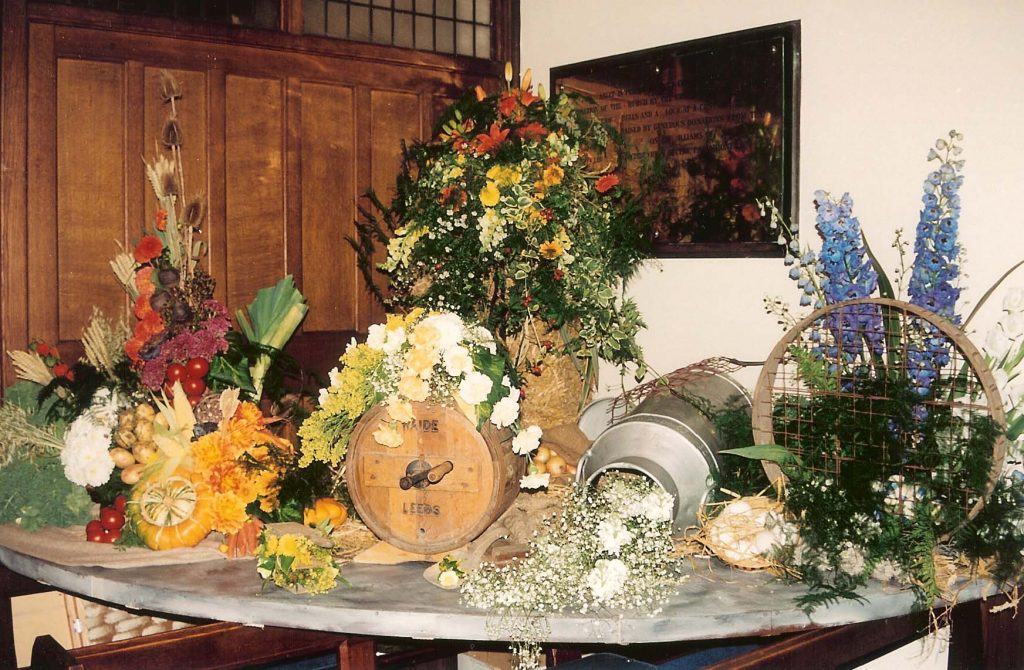

Historical Exhibition in the Parish Hall
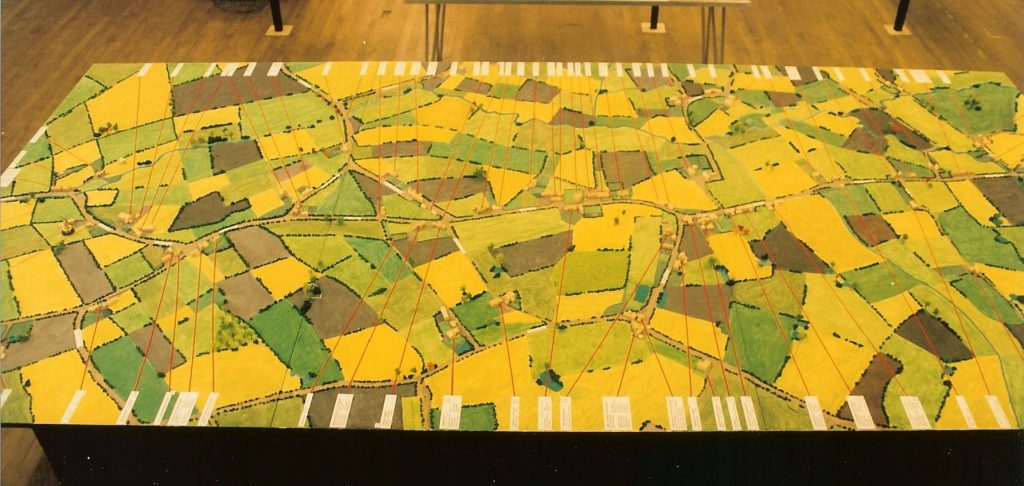
MODEL OF RAINFORD VILLAGE IN 1842
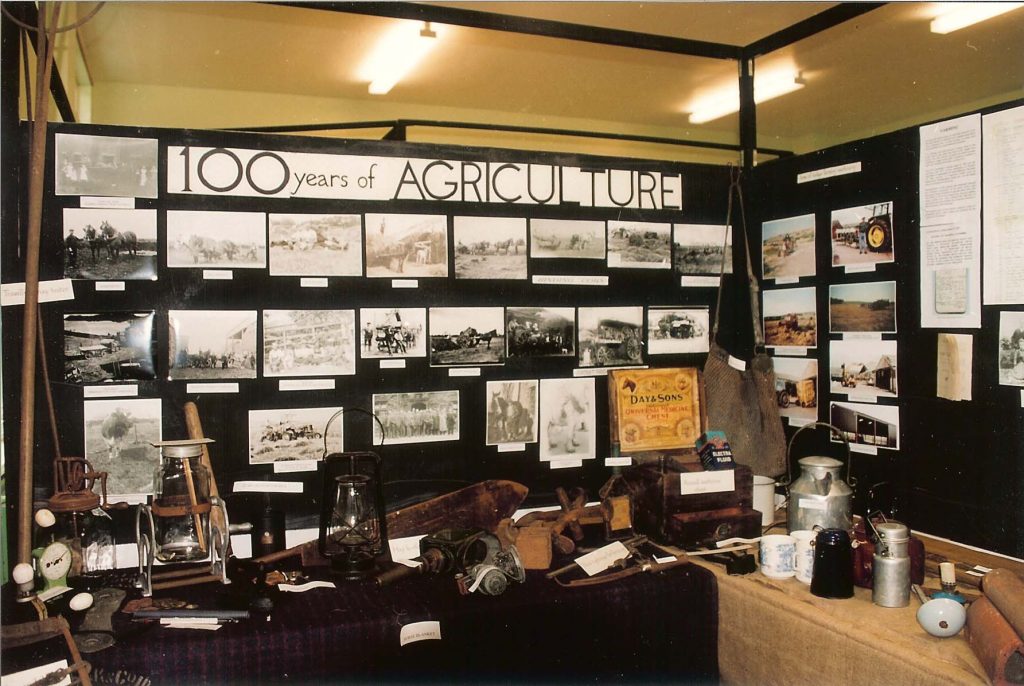
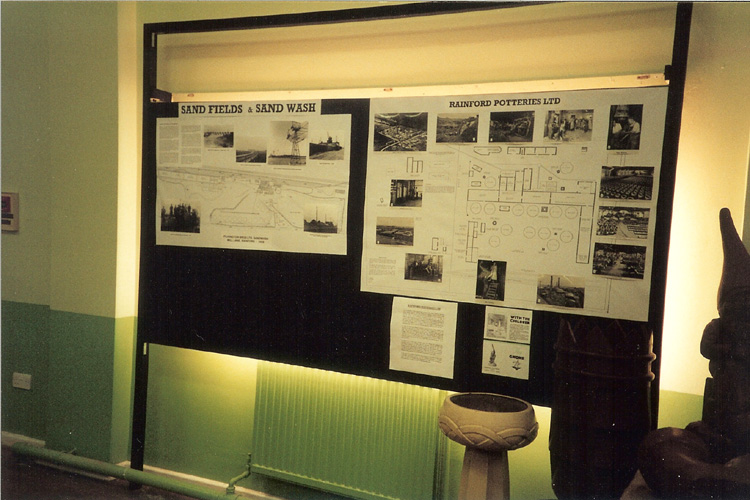

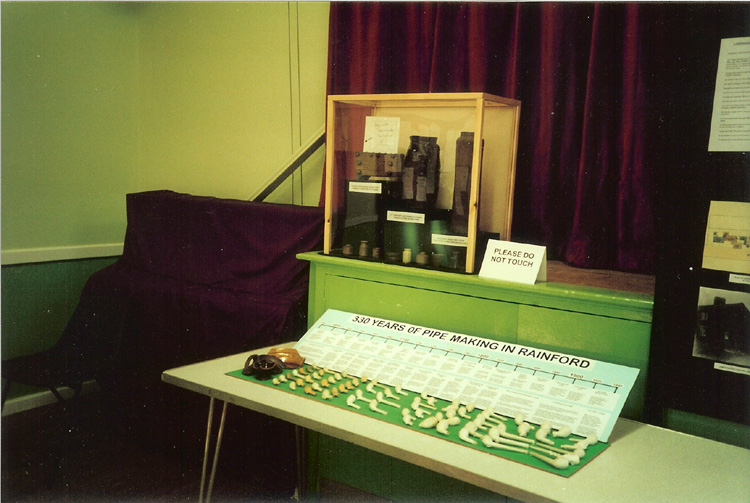
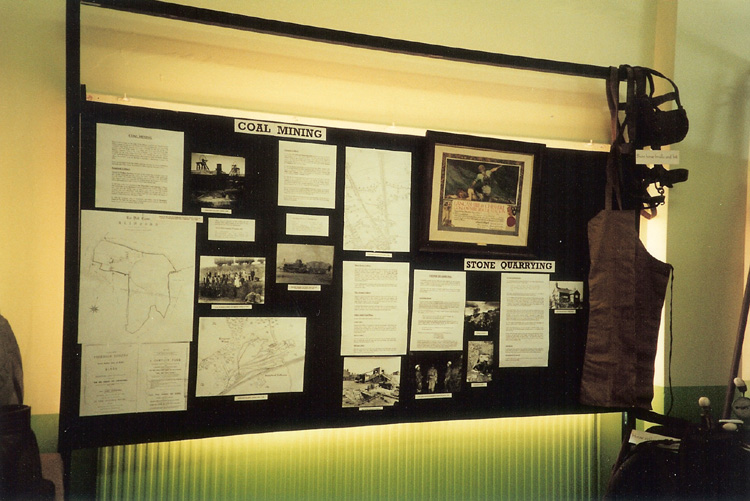

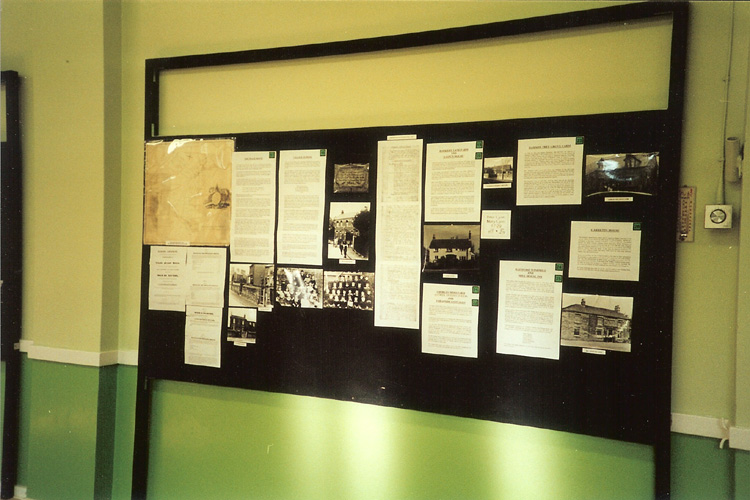
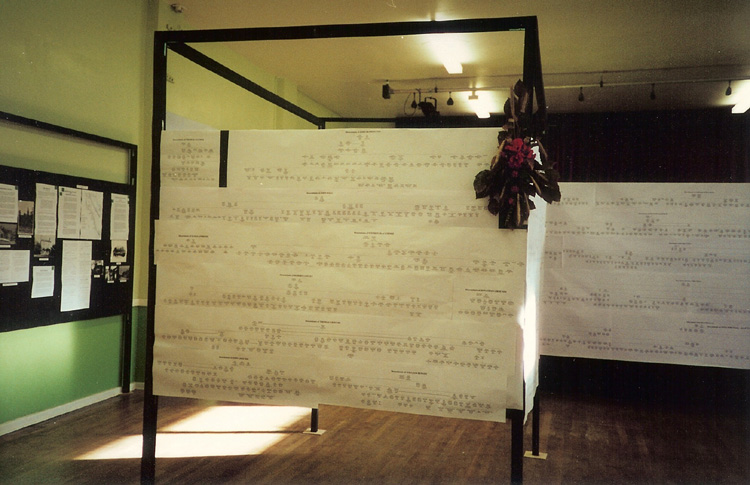
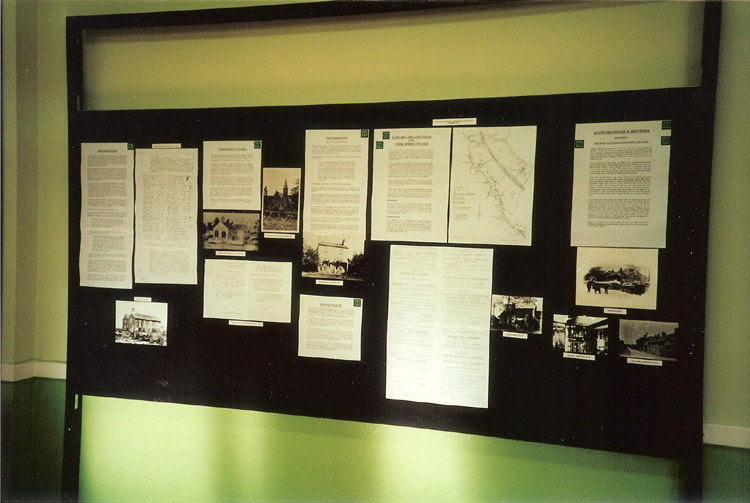
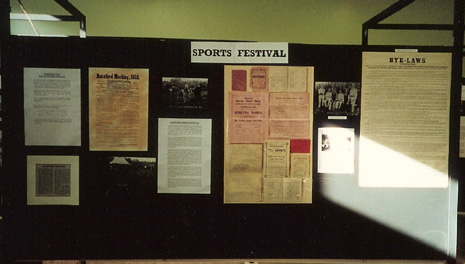
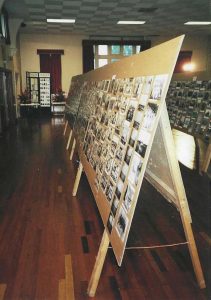
Photographic Exhibition in the Village Hall

WWI and WWII ROLL OF HONOUR
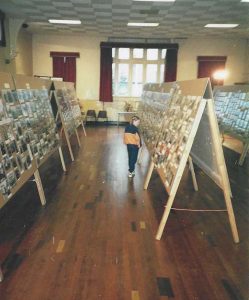
THE 125th ANNIVERSARY CELEBRATIONS 2003
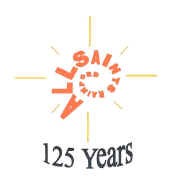
Rainford All Saints Parish Church was 125 years old on November 1st, 2003, and celebrations were held to mark this milestone in the history of the church by holding a weekend of special events which included :-
‘A NEW CHURCH FOR RAINFORD’
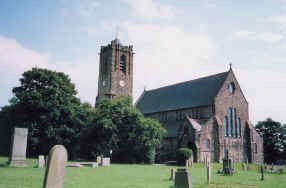
The two performances of “A New Church for Rainford” featuring a multimedia, live drama and musical presentation of the story of the church over the past 125 years, were a great success for invited guests, parishioners and their friends who came along to watch. With over 50 people from all the church organisations taking part live on stage, eight crew members working lighting, sound, video and scenery, plus others that appeared in the video sections, it was a great team effort which proved that when faced with a common goal and vision, the church unites with great enthusiasm.
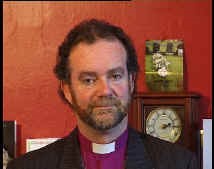
Rt. Rev. JAMES JONES BISHOP OF LIVERPOOL
After the opening welcome by Alf Webster, Chairman of the 125 Celebration Committee, the video commenced with a personal message to the church from the Bishop of Liverpool, the Rt. Rev. James Jones.
Throughout the video presentation there were interludes of live drama performed by the various organisations, each telling the story of how they were founded and how they continue to work together in friendship and fellowship.

THE LAYING OF THE FOUNDATION STONE
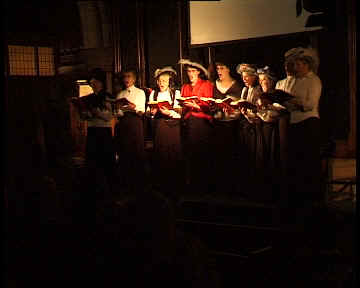
THE CHOIR
A special prayer was written for the occasion by the vicar Rev. F R N Michell :-
” Holy Father, the guardian and inspirer of the past, present and future, we give thanks for your grace and loving kindness that has been a beacon of light to the people of God in each generation in this place. We thank you for the faithfulness of our forefathers that laid the foundations and built this church. As we celebrate this story of faith, give us grace to make our contribution so that the future generations too will be blessed by the story of your grace and goodness towards us. This we ask through the name of him in whom past, present and future are one, even Jesus Christ, Our Lord. AMEN”
SPECIAL FESTIVAL SERVICE
To complete the weekend of celebration a special Sunday morning family worship service was held on 2nd November 2003 at 10.30am. The theme of the service was “HOPE” which concentrated on the hopes and plans for the church in the future. All the local schools and church youth groups took an active part in the service.
Following the service there was a time of fellowship and feasting with a Celebration Sunday Lunch held in the Parish Hall.

